In late April, I made the journey from Toronto to Shanghai at the start of my trip to China for the spring and summer. I’ve now exited my 14-day quarantine, and I’m spending this week in and around Shanghai before heading back to Beijing.
In this article, I wanted to document the travel experience from start to finish, including my pre-travel preparations, my flight on Air Canada 787 business class, and the hotel quarantine experience at Shanghai’s Blue Sky Hotel.
I’ve also made the following YouTube videos to show you the entire outbound journey of this trip, which you can watch below:
Preparing for the Trip
Getting a Visa
China has implemented strict border controls since the onset of the pandemic. Previous visas for foreign passport holders have been suspended until further notice, and new visa applications are being screened through a dedicated email service before you’re invited to submit your application at your local visa centre.
As I mentioned in the intro post for this trip, I was travelling to China on a newly-issued family reunion visa which I obtained on humanitarian grounds.
I completed the visa process over several weeks back in January (after renewing my Canadian passport at the turn of the year), which required a considerable volume of supporting material, including hospital records and documents to prove family relationships.
If any readers are hoping to make a similar trip to China, I’d recommend contacting your local visa office in Vancouver, Calgary, Toronto, or Montreal for the most up-to-date list of eligible applicants and required documents.
Booking the Flight
Like many other countries in the Eastern hemisphere, China also currently places strict limits on the number of international flights coming into the country.
Travellers coming from Canada must take non-stop flights on their inbound journey, and I had booked myself on the once-weekly Air Canada 787 business class service from Toronto to Shanghai.
(Thanks to an involuntary schedule change on an Aeroplan award ticket that I had booked under the old program, I didn’t have to pay the dynamic pricing of 200,000+ Aeroplan points for a newly-booked one-way flight. While I would’ve preferred to take the once-weekly Vancouver–Shanghai service, I wasn’t able to get the origin changed from Toronto to Vancouver, so I instead flew Air Canada premium economy to Toronto to begin this journey.)
COVID-19 Testing
Prior to travelling, I needed to take two separate COVID-19 tests: a PCR test and an antigen test, both within two days of the flight.
(The antigen test in particular is very heavy-handed compared to other countries which only require a PCR test, as it could create complications for someone who had previously already recovered from COVID-19.)
Moreover, the “two days” requirement might’ve proven tricky, considering that my flight was departing at 1:20am on a Sunday, and I still needed to travel from Vancouver to Toronto in the days prior to it.
Fortunately, I confirmed with the consulate that it wasn’t a strict 48-hour rule. Instead, since check-in would take place on Saturday evening, I’d be okay if I took my tests on the morning of the preceding Thursday.
That’s exactly what I did, booking my PCR test at PolyCan Health Centre near Simon Fraser University for a total cost of $315. Upon completing my test, I was then directed to the LifeLabs facility on East Hastings St for my antigen test, which cost a further $75.
Both test results came through within 24 hours by Friday morning, via a single email from PolyCan.
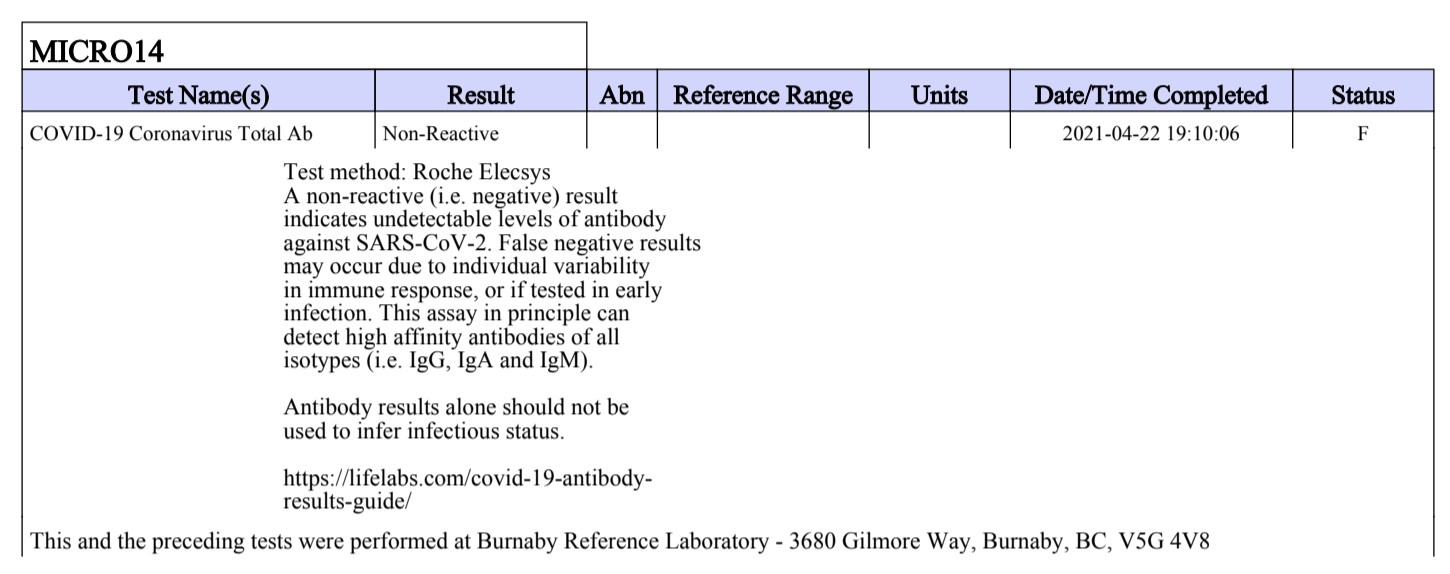
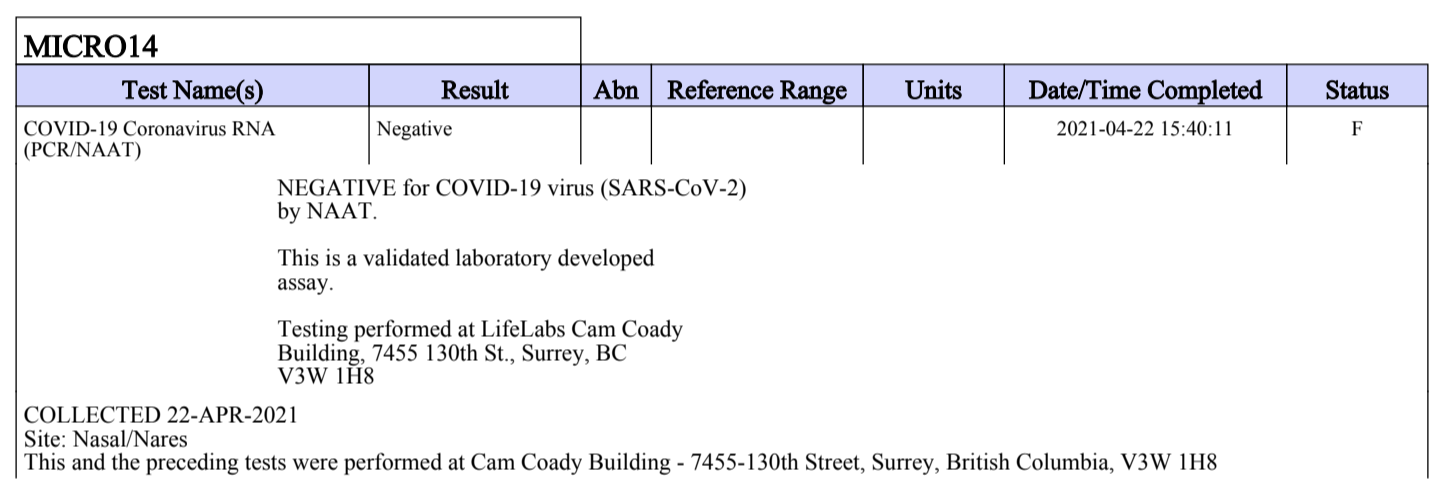
Pre-Flight Procedures
With the two negative tests in hand, I then boarded my Air Canada premium economy flight en route to Toronto on Saturday, in advance of my Shanghai-bound flight in the early hours of Sunday.
It was only after I landed in Toronto that I finally got around to uploading the two negative tests to the Health Declaration Certificate portal, which all international travellers must complete before boarding their China-bound flight. Only after someone reviews and approves your health documents do you receive your green health code, which allows you to board.

(Indeed, when I tried to check my bags at the Air Canada business class check-in counters so that I could head to Downtown Toronto with a lighter load on my layover, the agent said that she’d need to see my “green spinning thing” to be able to check me in and take my bags, so I ended up having to bring my bags with me.)
I waited very nervously for my green health code to show up for the rest of the day. Just as the clock struck 9pm and I was about to head back to the airport with a mindset of “whatever will be will be”, the green health code finally appeared, granting me safe passage onto the flight in about four hours’ time.
In hindsight, I should’ve definitely taken action on this sooner instead of leaving it late. After all, when it comes to travel these days, even a small misstep or delay can be costly.
Air Canada 787 Business Class, Toronto to Shanghai
It’s been a while since I had written our in-depth review of Air Canada 787 business class.
I had considered writing a full-length report of this flight from Toronto to Shanghai. But given its many unusual characteristics in these unusual times, I’ll simply share some brief impressions from the 17-hour journey, and I’ll save the refreshed Air Canada business class review for a future trip.
(Why 17 hours? Well, Air Canada currently operates both of its Shanghai-bound services with a one-hour technical stop in Seoul, because South Korea’s crew quarantine requirements are apparently much less strict than China’s. One set of flight crew operates the flight from Canada to Seoul, and then another crew takes over for the Seoul–Shanghai segment before doing a direct turn, thus avoiding the need to quarantine in China.)
At the Airport
After completing my check-in procedures at a deserted Toronto Pearson International Airport, I headed to the Air Canada Maple Leaf Lounge to unwind before my flight.
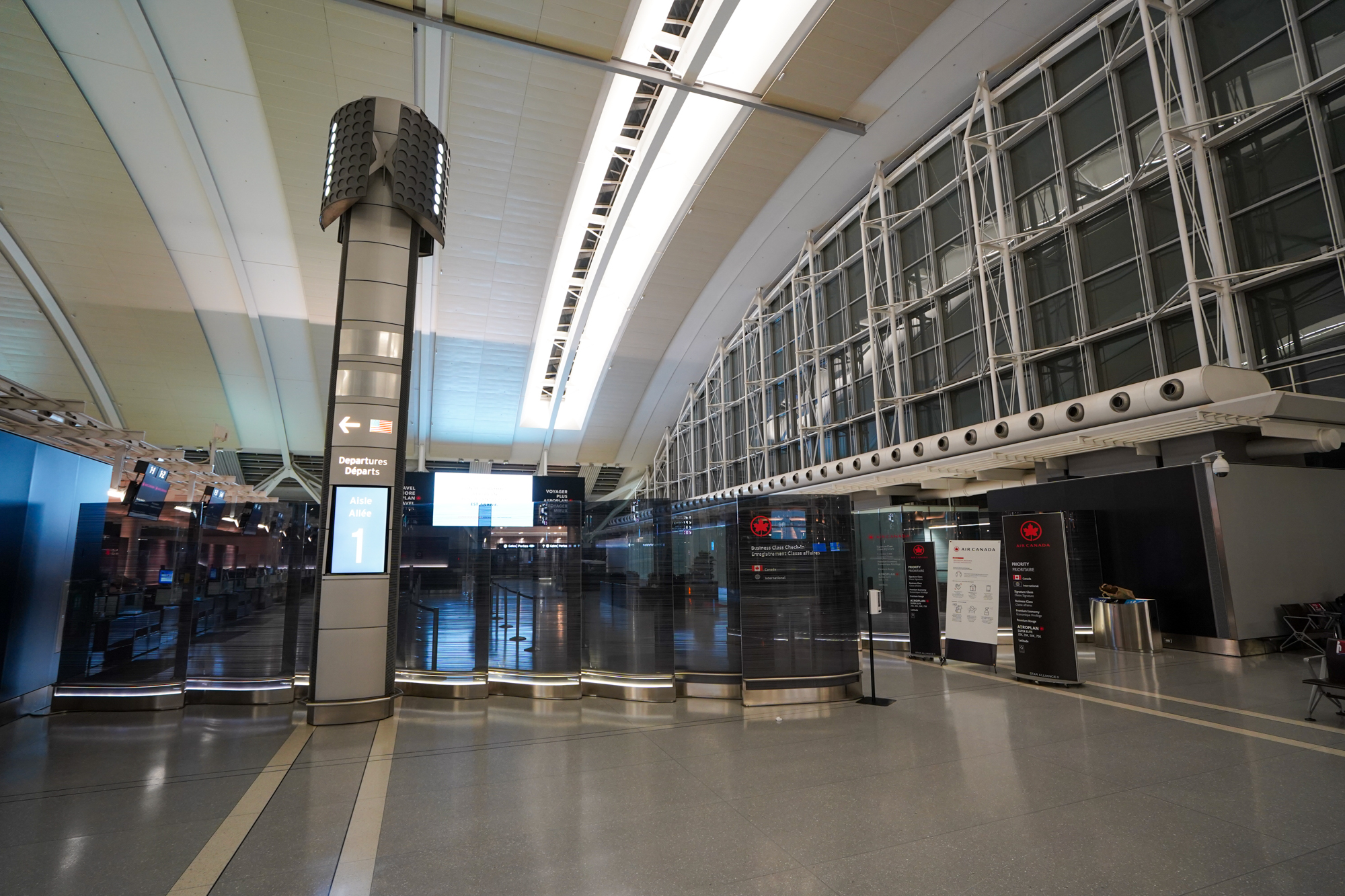
The international lounge remains closed for the time being, although it’s possible to visit the domestic lounge for some refreshments before making the long walk to the international terminal.
The Maple Leaf Lounge à table food service had already ended by this late hour, so I simply enjoyed some grab-and-go snacks and a glass of wine – in the company of just one or two other passengers in the entire lounge.
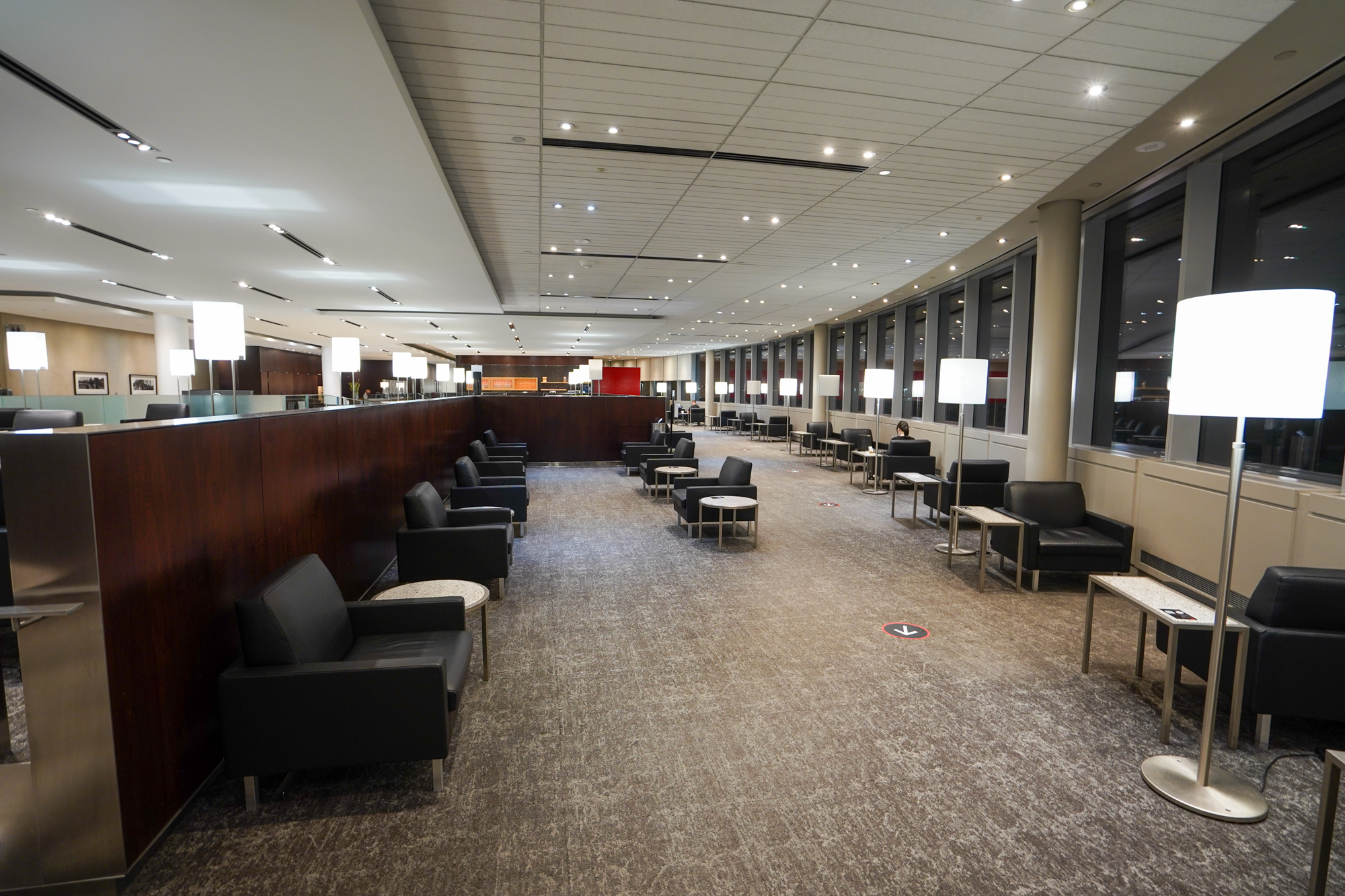

It was about a five-minute walk to the “E” gates, large stretches of it with not a single soul in sight. I then spent a good 30 minutes picking out a laundry list of duty-free items for my mum, after which it was time to board.
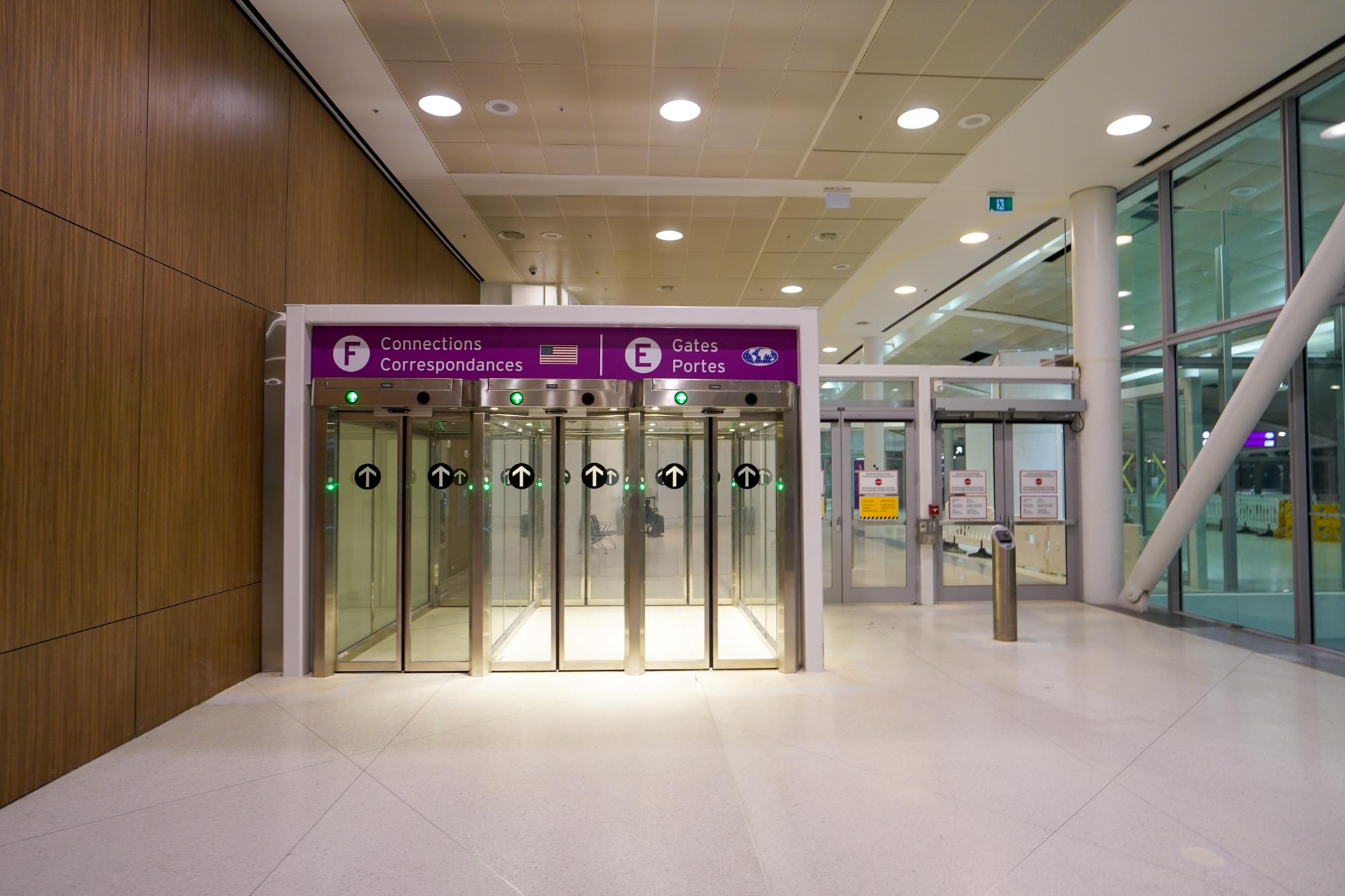
Boarding
All 30 business class seats were occupied on tonight’s flight, and many of the passengers appeared to be Chinese students returning home after their semester of university. I got the sense that few, if any, of them had redeemed Aeroplan points for this flight rather than paying cash. 😉
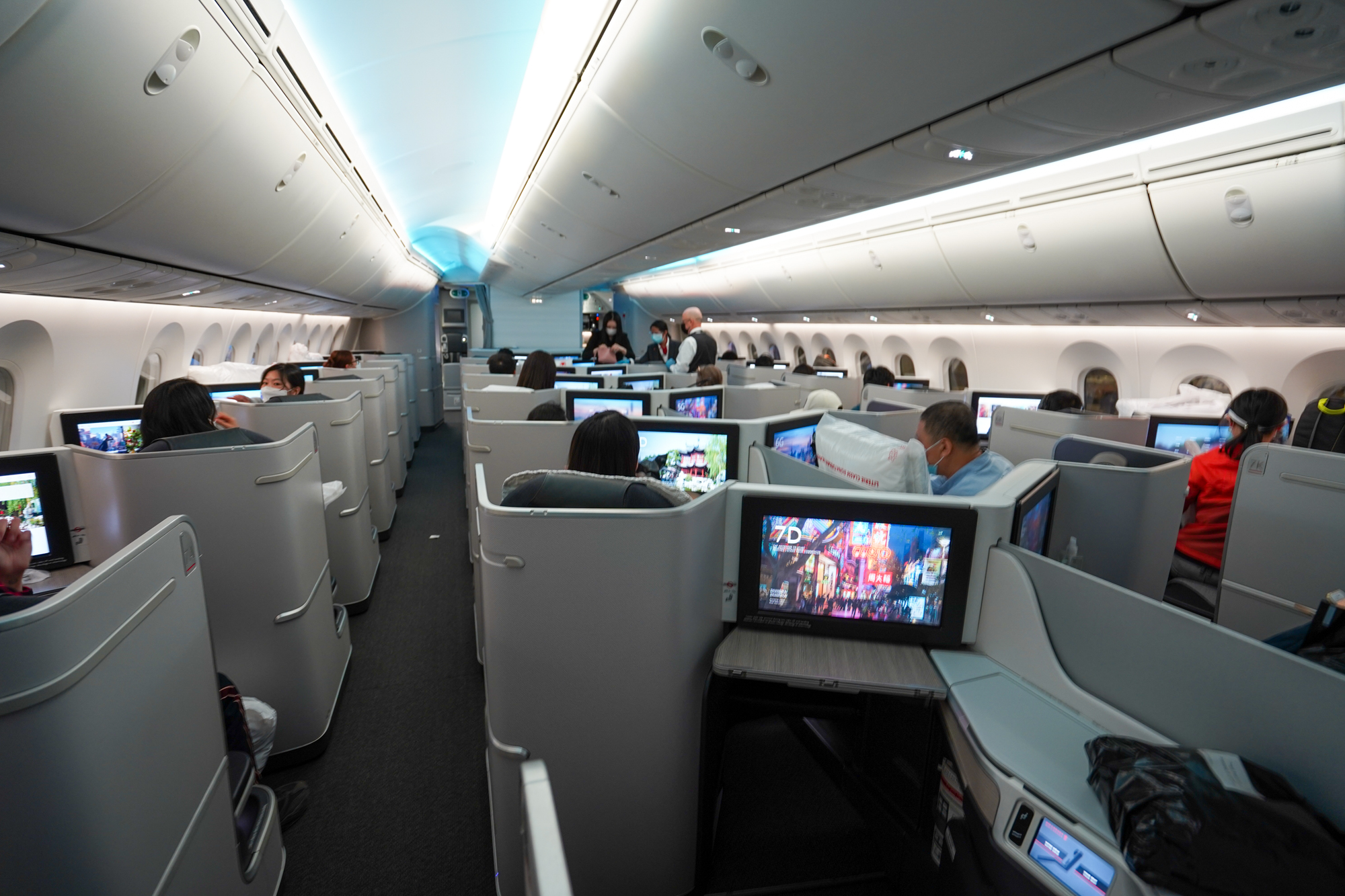
I had originally assigned myself Seat 7A, having been stuck in an aisle seat previously before snagging a window seat at the last minute. The passenger in Seat 4A asked if I’d swap seats with him so he could sit next to his partner in Seat 7D, and without thinking about it too much, I agreed (as I usually do when it’s a reasonable seat swap request).
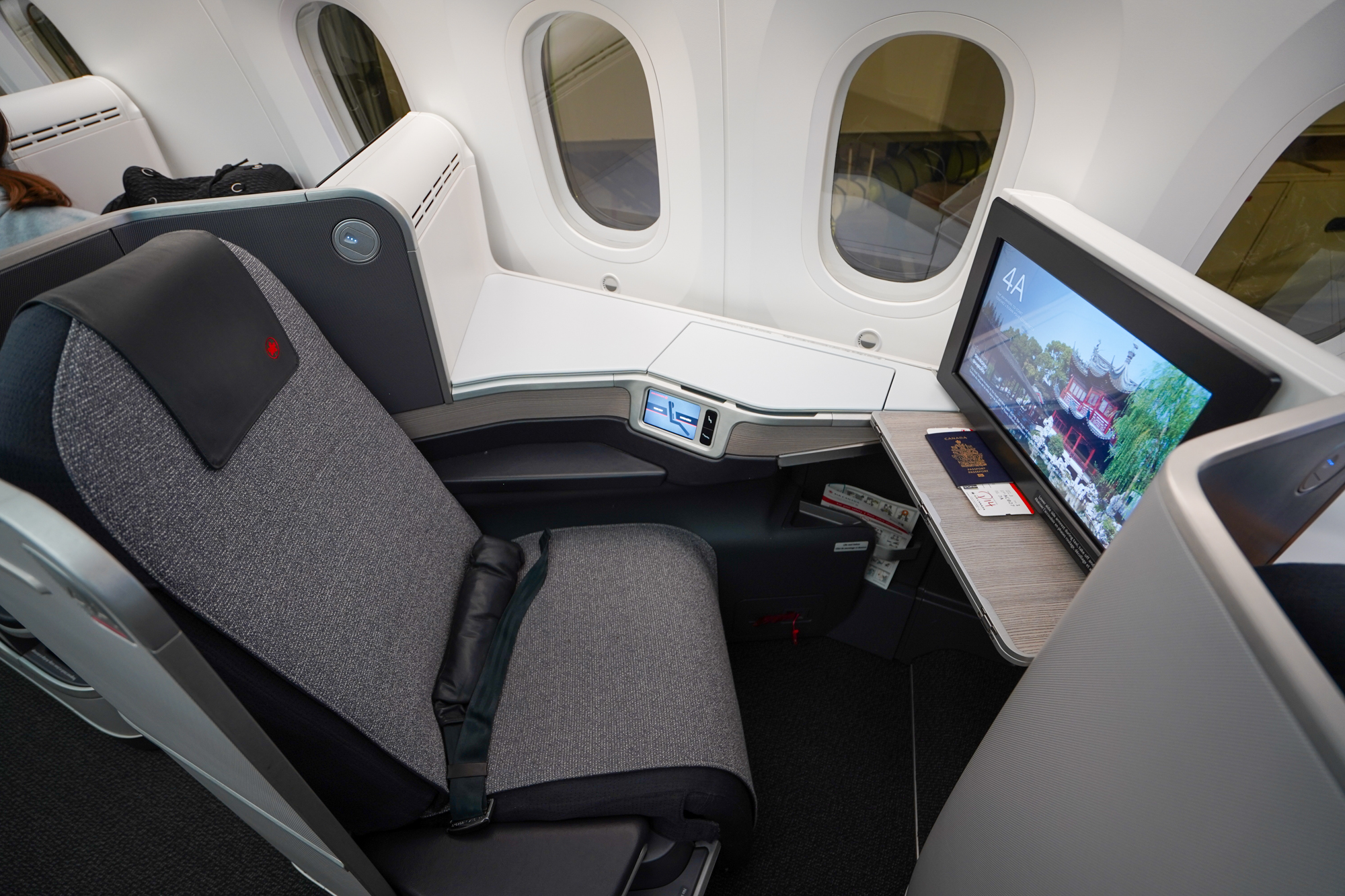

However, I soon realized that I probably shouldn’t have. Our seat numbers were being carefully tracked for contact tracing purposes, after all, and the swapped seats could put me in a spot of bother if, say, the person in Seat 8A ended up testing positive later on.
Thankfully, that particular nightmare scenario did not play out in the end, but it was a reminder to myself of how we must think more consciously about our travel behaviours as we emerge into a post-pandemic world.
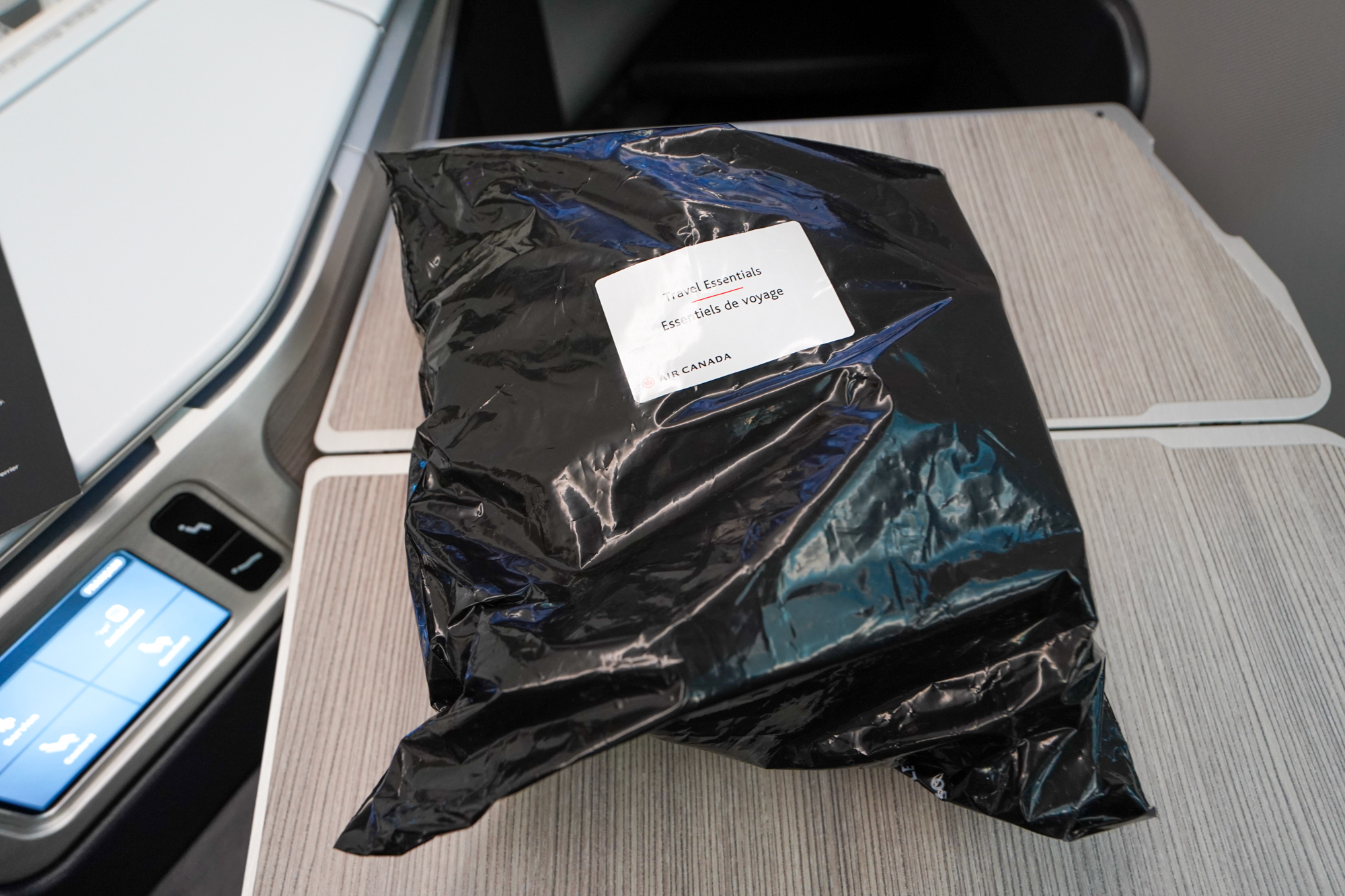
Settling into an ever-so-familiar Air Canada 787 business class seat, I took notice of the fact that all of our in-flight items now came in a single plastic bag marked with “Travel Essentials”. Inside, I discovered the headphones, CleanCare+ kit, and amenity kit by Want Les Essentiels.
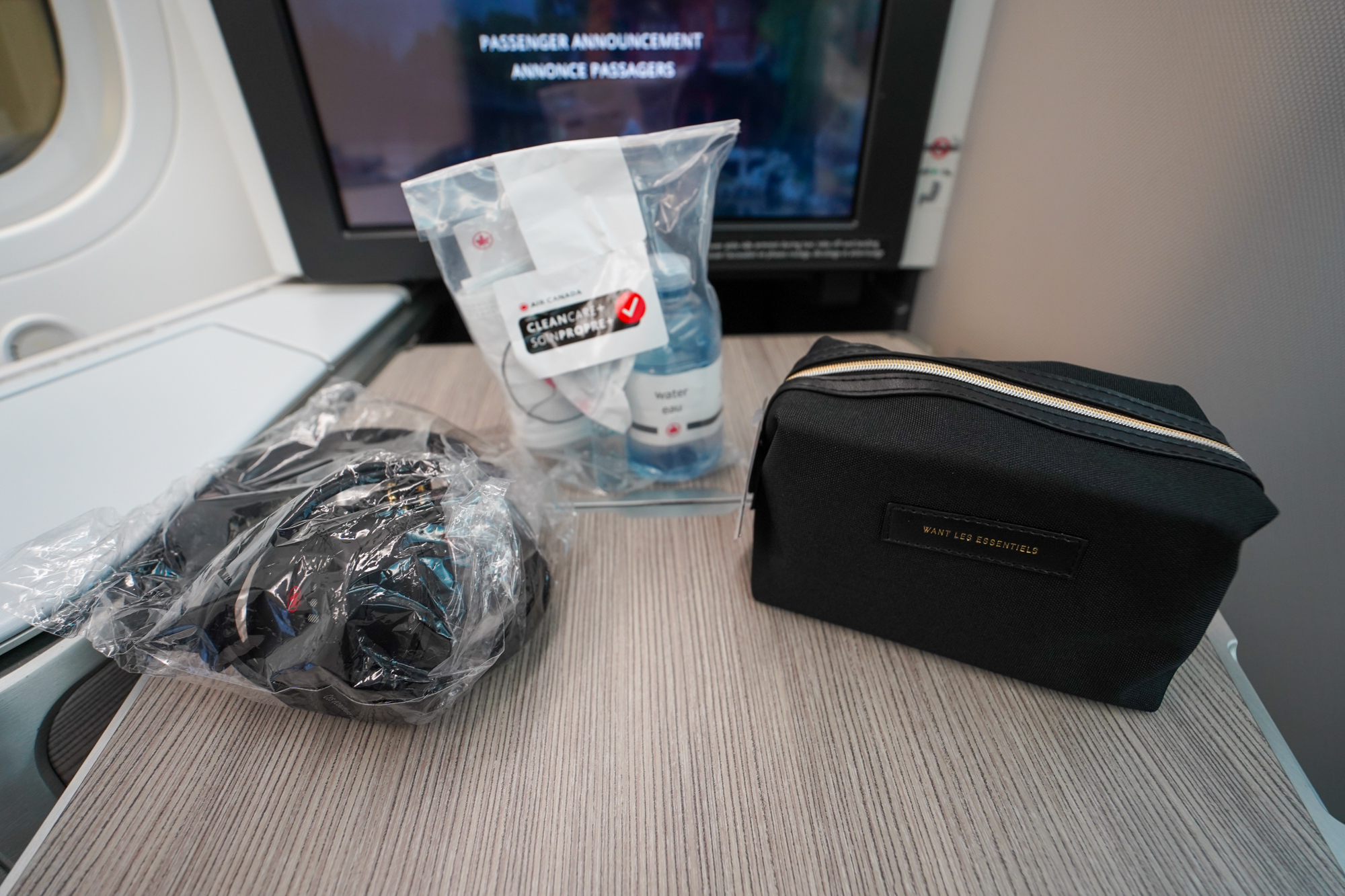
Other than that, nothing felt too different compared to flying in the old days. As with most early-morning departures, I dozed off for a while during the takeoff roll, waking up only as the crew were rolling out the meal carts.
Meal Service
As I discovered to great delight, Air Canada has phased out the “boxed meals” in business class. They haven’t quite restored the full multi-course meal service, and there’s still only one appetizer and main course to choose from – but at least the individual dishes are served in proper bowls and plates.
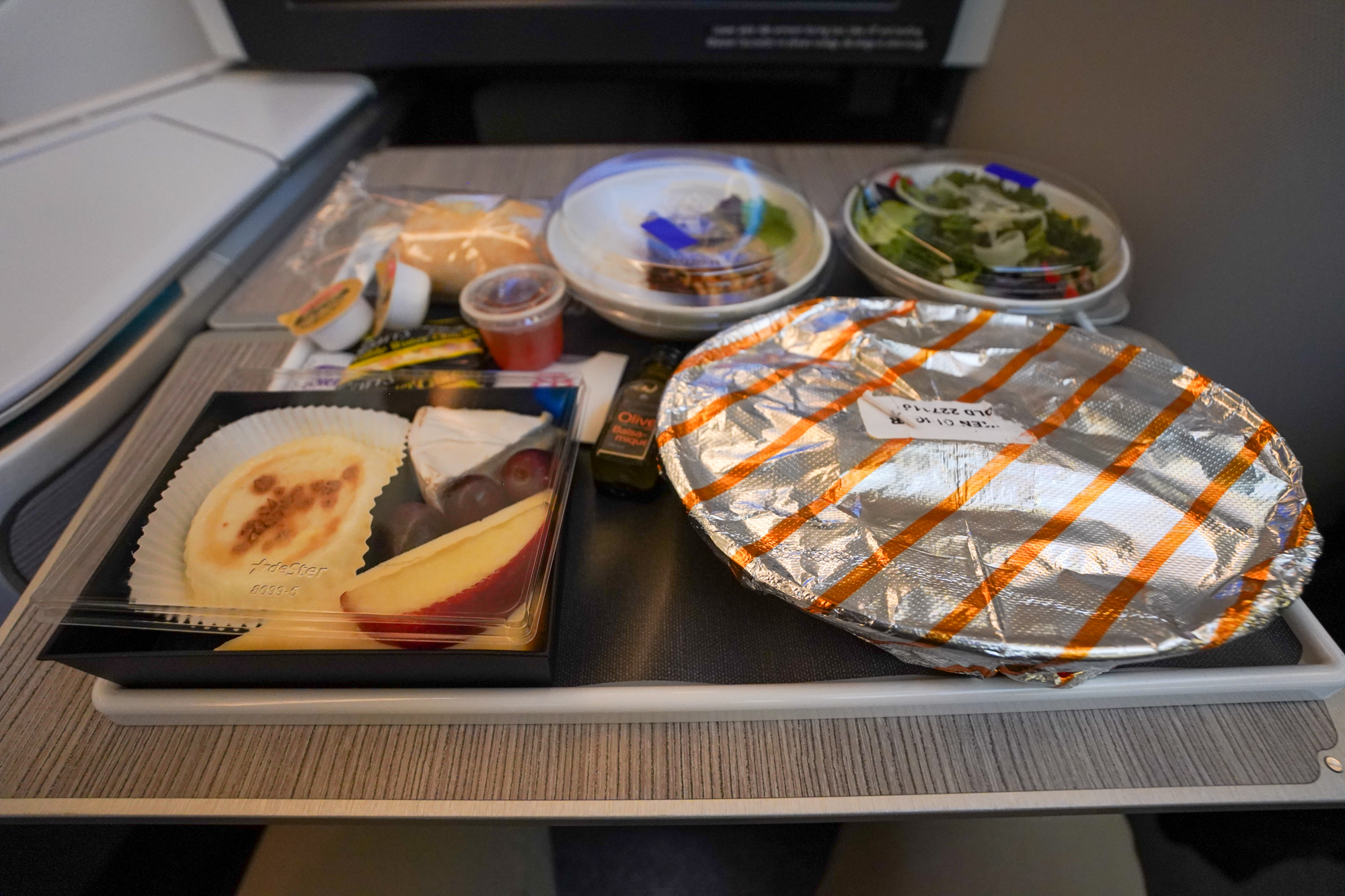
Asia-bound flights are catered by Chef Antonio Park, and I very much enjoyed his ginger-inspired beef and chicken dishes for my appetizer and main course, along with a glass of the Laurent-Perrier champagne.
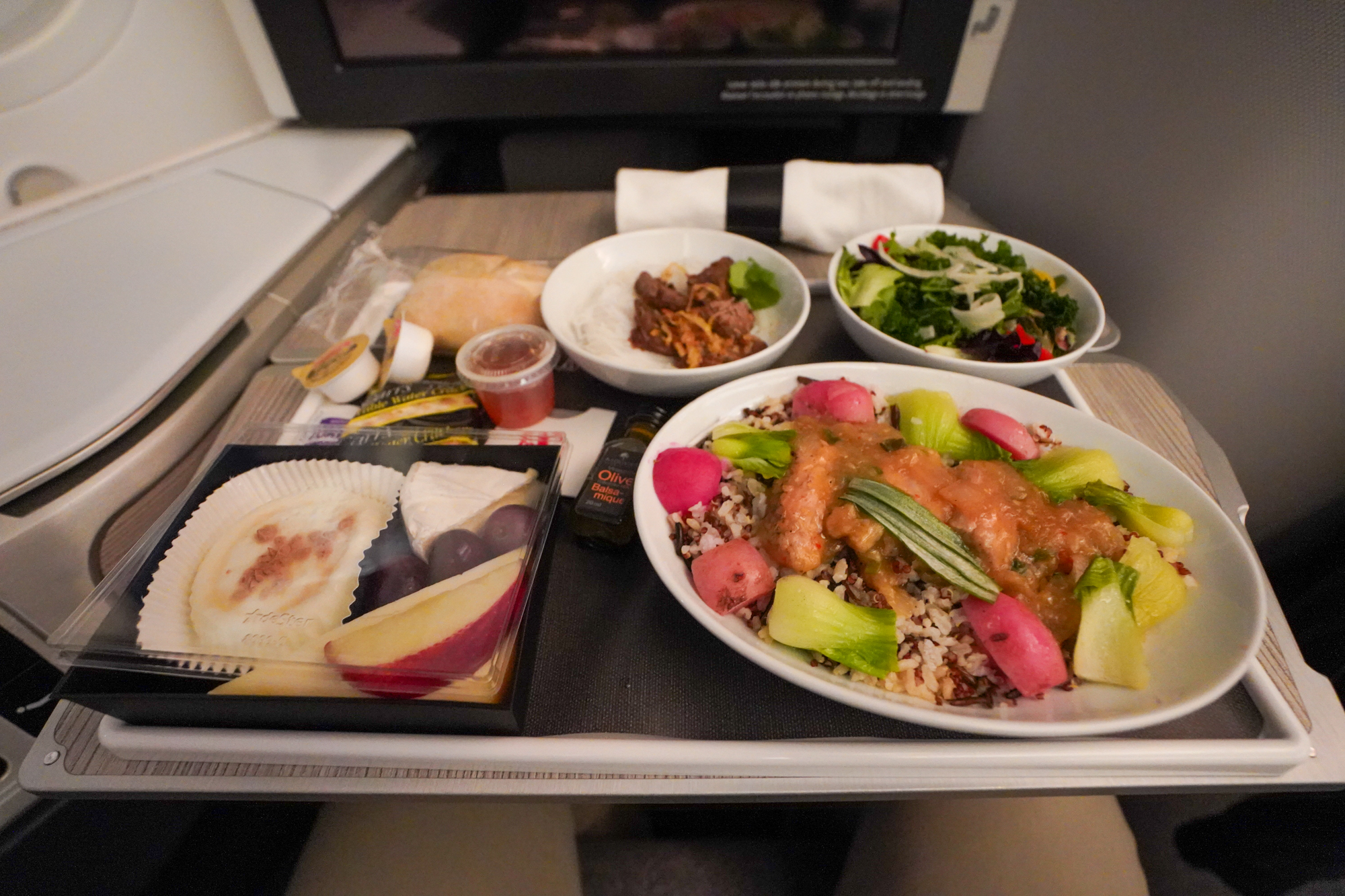
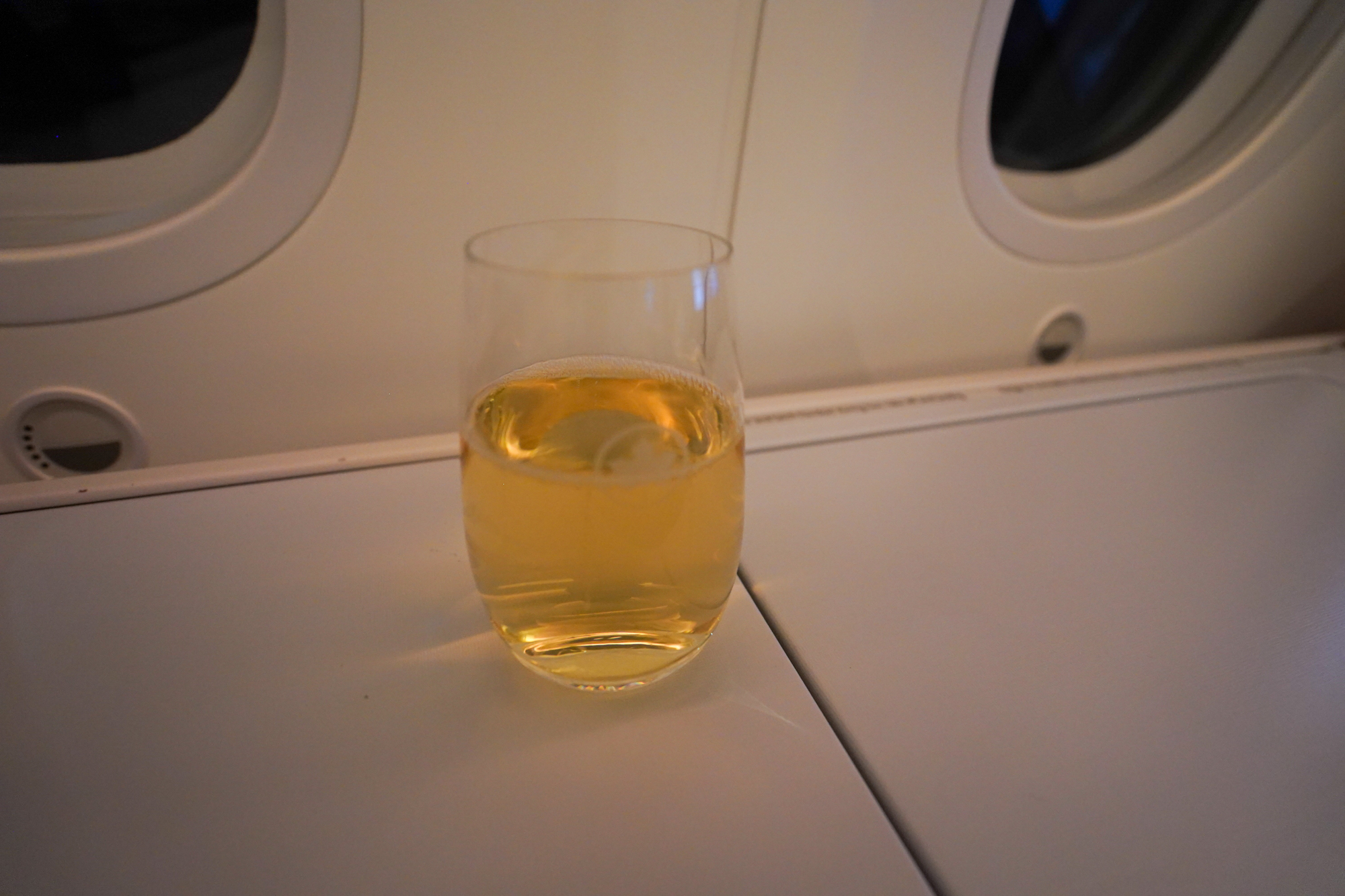
In my eyes, Air Canada has restored its international business class catering to a respectable level, but no more than that. By now, many airlines around the world have resumed their full onboard service with multiple choices per meal (including vegetarian and vegan options), so Air Canada’s streamlined service concept boils down to continued cost-cutting rather than motivated by health and hygiene.
In-Flight
After the meal, I got a bit of work done on my laptop, and then proceeded to sleep for an entire nine and a half hours uninterrupted (which is probably the longest continuous sleep I’ve ever had on a plane).

I had been awake since very early in the morning the previous day back in Vancouver, and it was well past 3am Eastern Time by now, so I naturally had very little energy left in the tank.
Indeed, I vaguely recall the crew member asking if I’d like to eat my second meal, and then placing it down on my table after I nodded in agreement. When I actually woke up, though, the meal was nowhere to be seen, as we were 30 minutes away from landing at Seoul Incheon International Airport.
Our one-hour technical stop in Seoul took place in the wee hours of the morning, and as passengers we weren’t allowed to leave our seats or get off the plane.
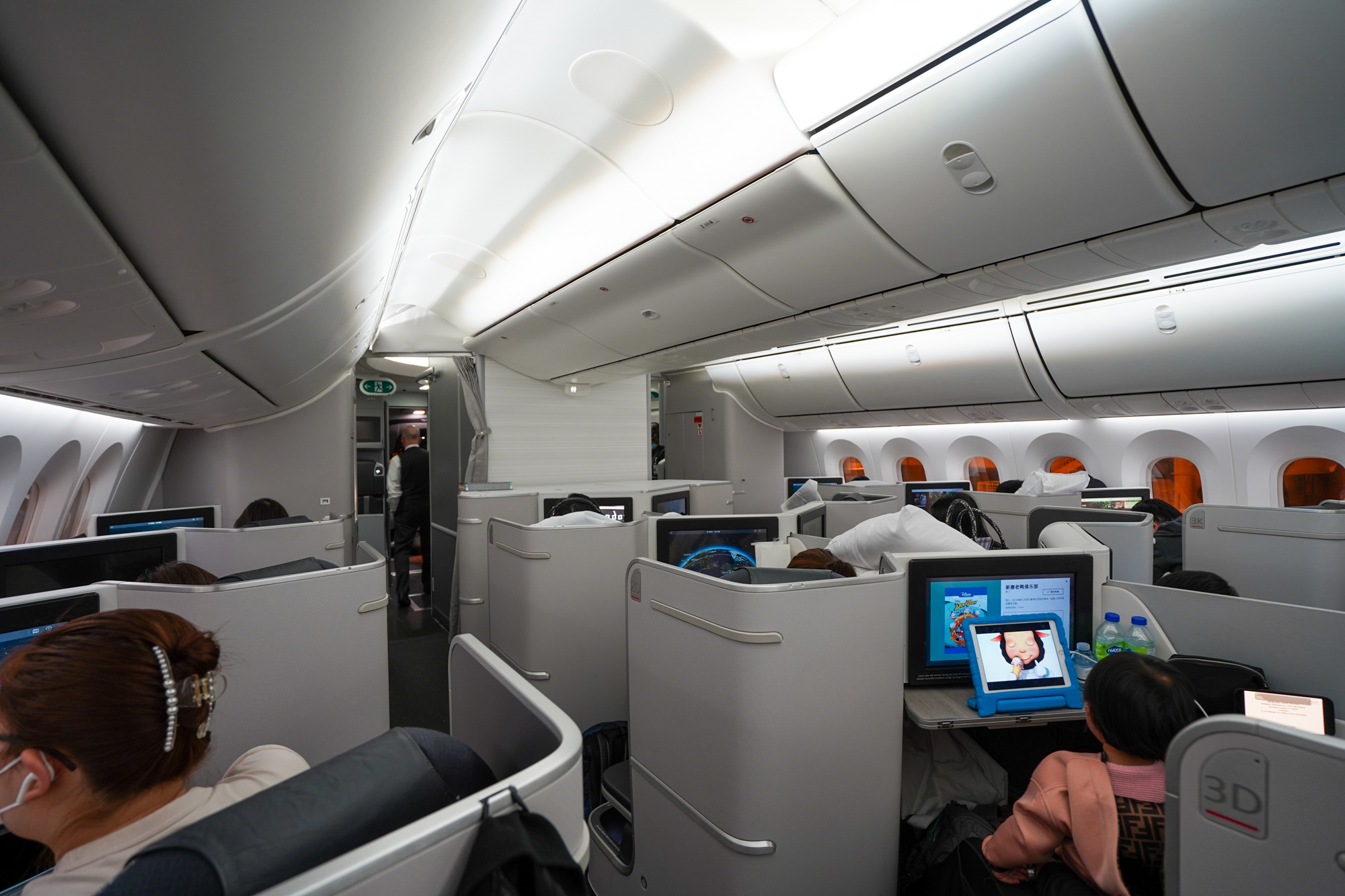
The pilots and flight attendants gathered their belongings and shuffled off the plane, before being replaced by a new set. In the meantime, I stared wistfully outside at the airport gates, reminiscing about all the good times on Asiana Airlines First Class and Korean Air First Class back in the day.
Once we took off in the skies again, we were treated to a truly spectacular sunrise view – the kind of wingtip views we’ve all dearly missed over the past year or so!

It was only another 90 minutes to hop across the East China Sea, and the meal service on this short segment was limited to a packet of snacks and some coffee or tea. Having missed out on the more substantial meal earlier on, these snacks would need to be enough to tide me over until lunchtime in Shanghai.
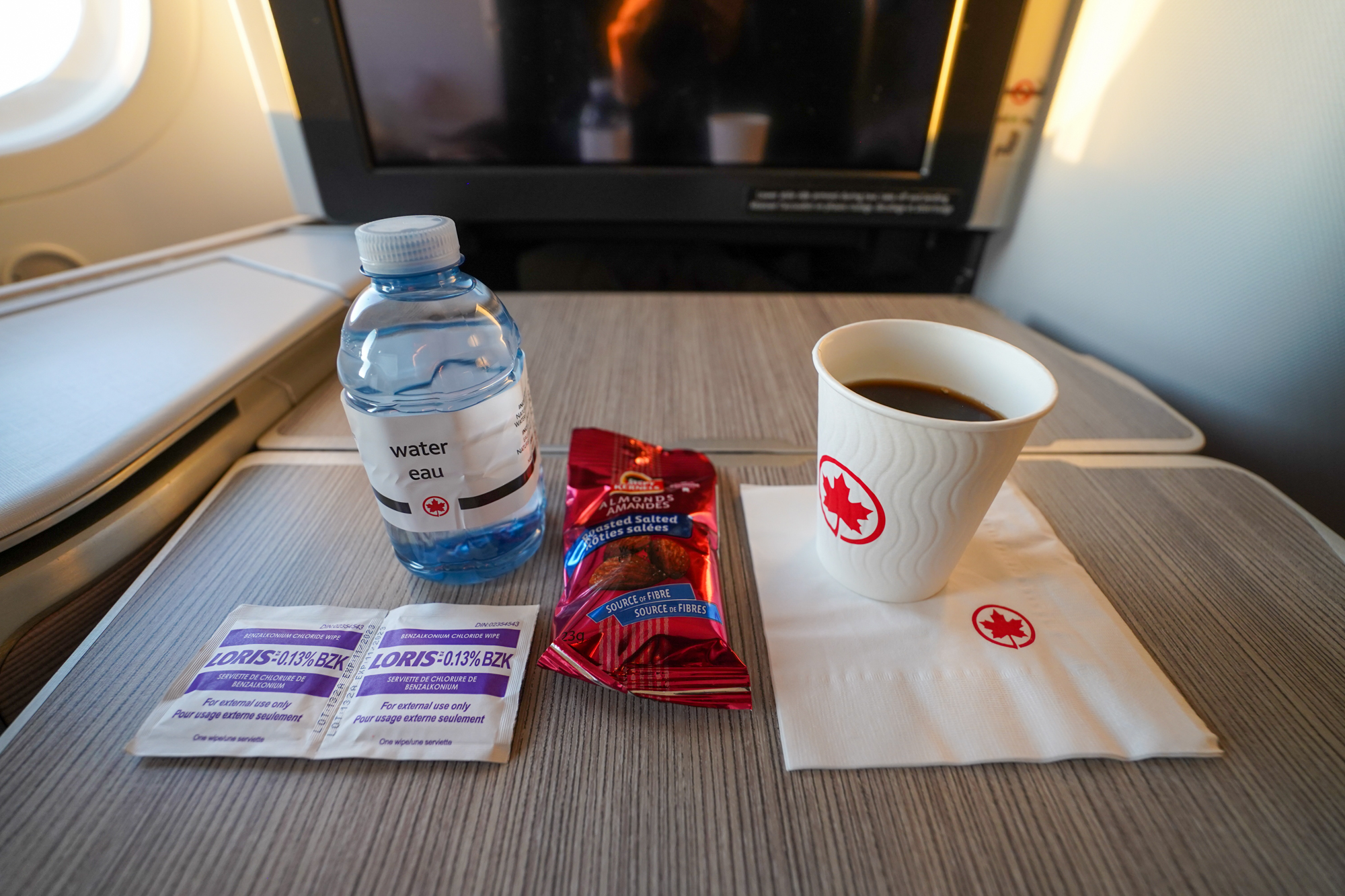
Disembarkation
Upon landing, a health official came onboard to inspect the aircraft, decked out in full personal protective equipment – as everyone we’d encounter from now on would be. I’m not quite sure what kind of “inspection” they had to perform, but we were told that we could disembark after a few minutes’ time, starting with business class passengers.
We were ushered into the arrival concourse of Shanghai Pudong International Airport in a roughly single-file formation.

The airport’s existing concourse has been segregated into a more complex maze of walkways using temporary metal walls, directing us from the aircraft as follows: first to a registration desk, then to another desk to pick up our COVID-19 PCR sample container, then to the actual testing facility to complete our tests (nasal and throat, with the nasal one extending particularly deep), and then onwards to the usual immigration checkpoint and baggage queue.
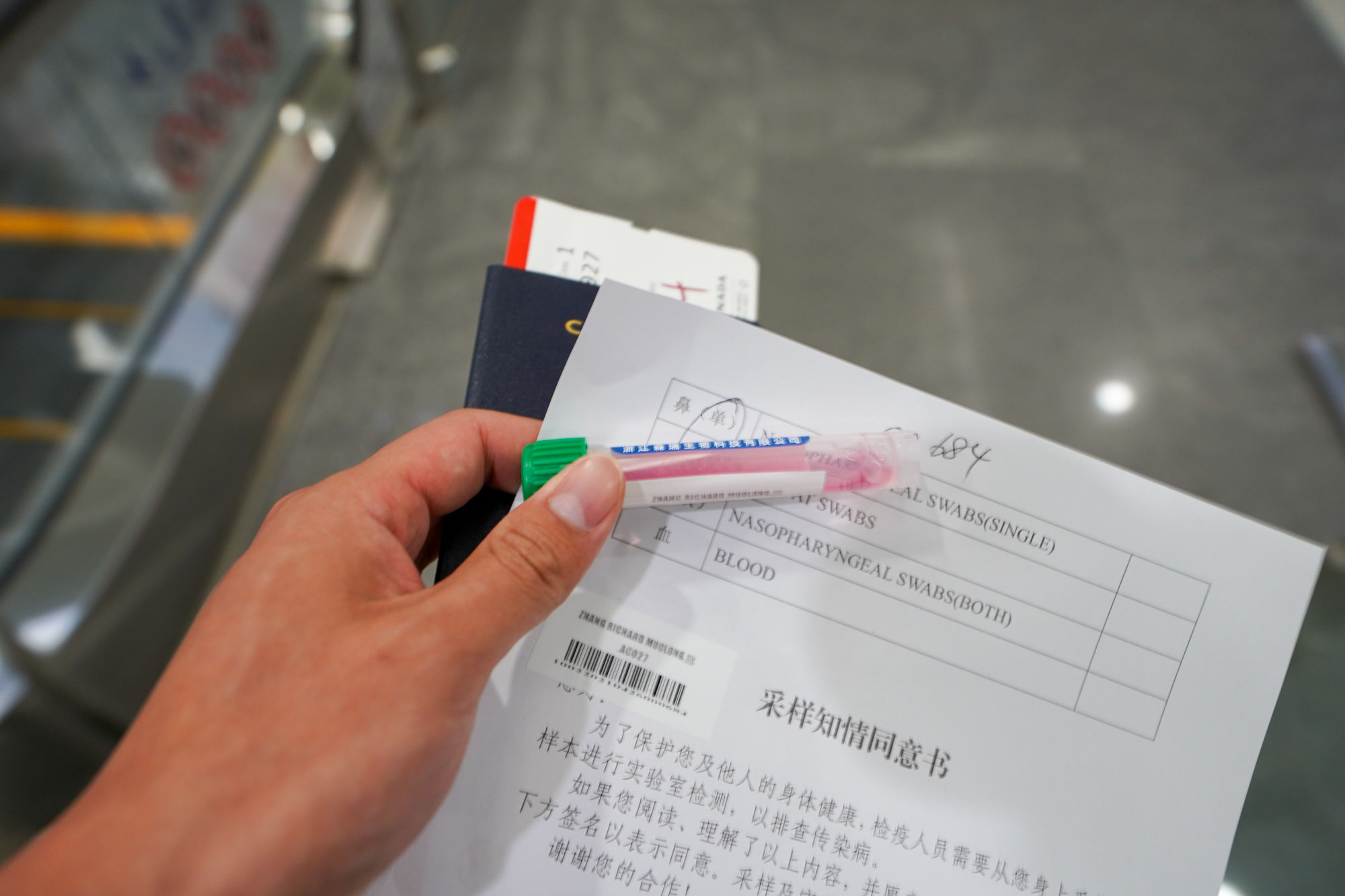
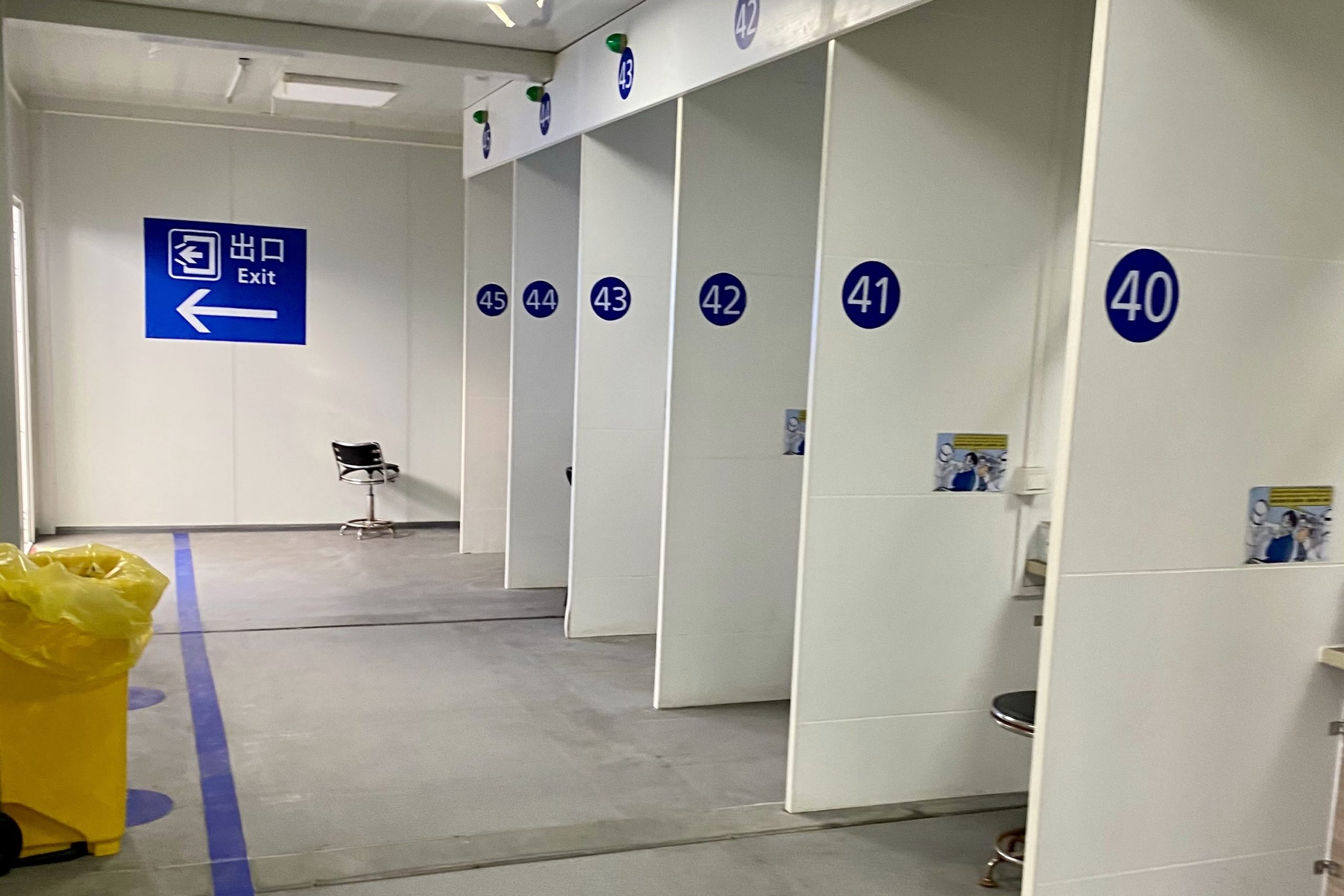
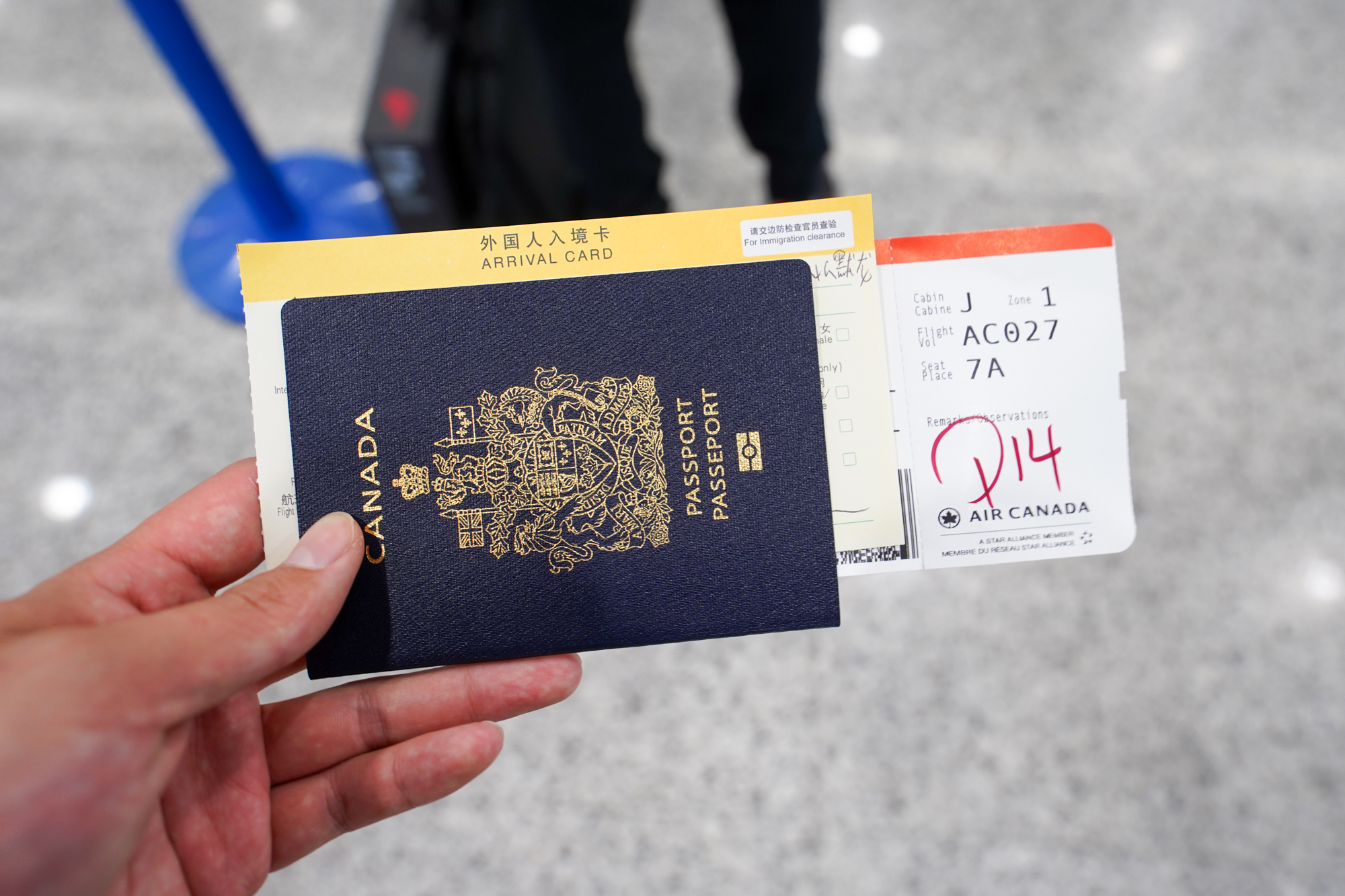
Eventually, after picking up our bags, we were directed towards a series of “pens” in groups of about 20 passengers, with each group headed to a different quarantine hotel. Our passports were collected at this point, and would be returned to us upon checking in to our quarantine hotel stay.
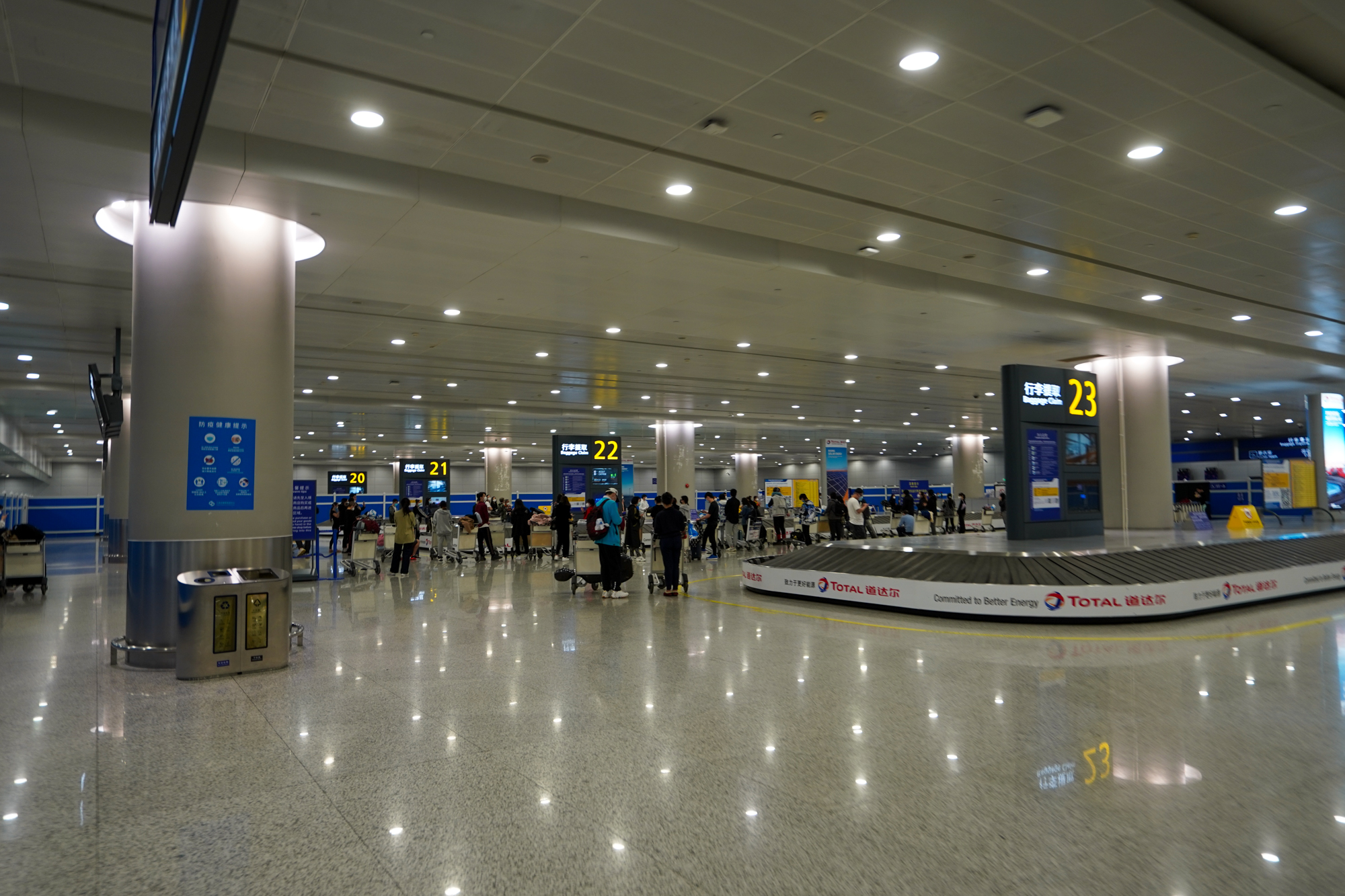
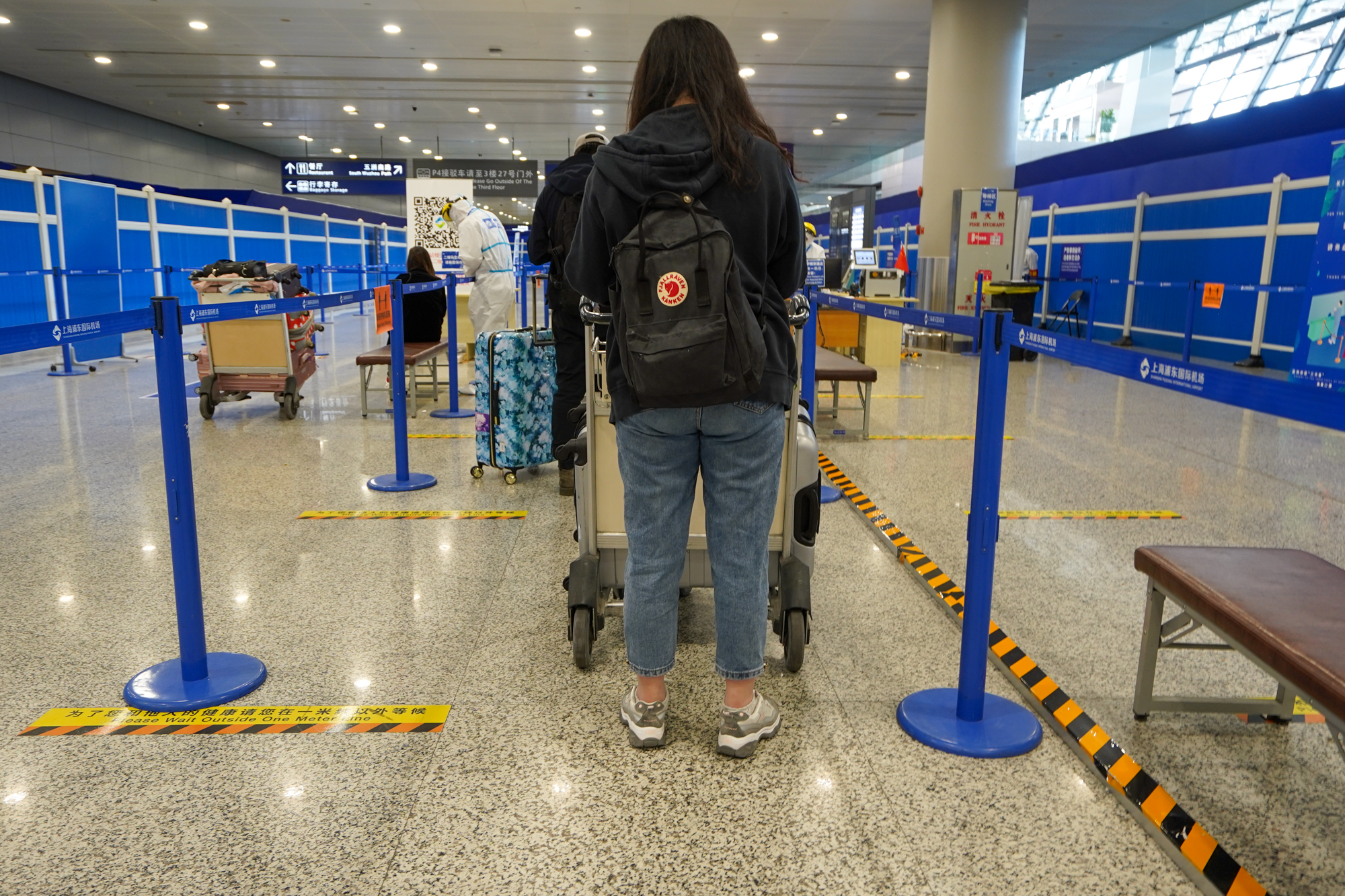
(Technically, we aren’t given the choice of which quarantine hotel to stay at. However, it’s my understanding that this is the stage at which I might’ve been able to ask one of the staff members which quarantine hotel the group was headed towards, and then request a different hotel if I didn’t like the sound of it. In my state of exhaustion, though, I decided to leave things up to fate.)
Heading down yet another series of walkways, we eventually gathered at Exit 29 of the airport, before making our way onboard the bus – sealed on the inside between the inbound travellers and the bus driver – en route to a mystery location for 14 days of hotel quarantine.

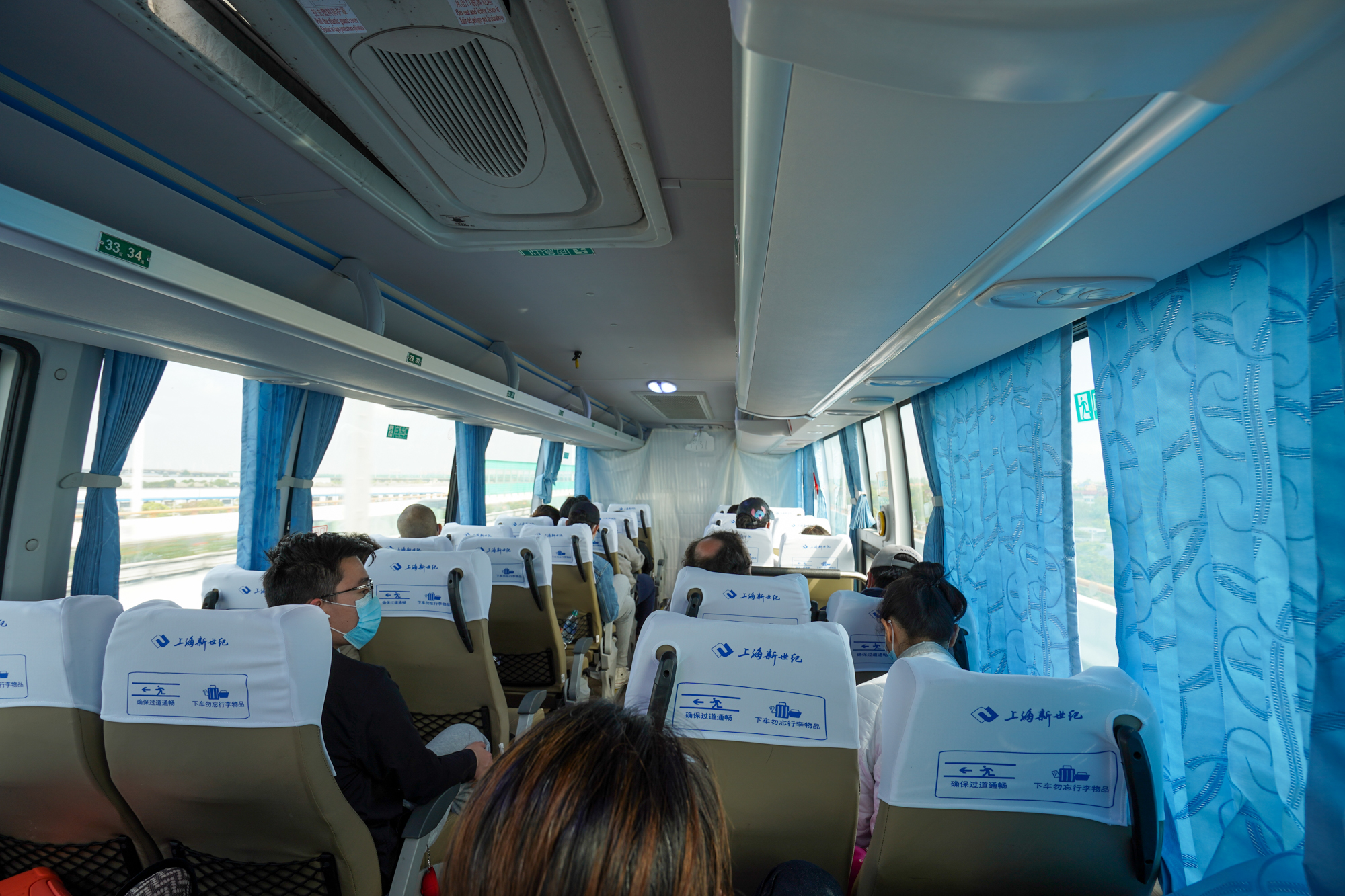
14-Day Quarantine at the Blue Sky Hotel, Shanghai
After about half an hour, our bus pulled up besides a nondescript building in the Yangpu District, right next to the Wujiaochang roundabout. This was a place I’d get to know very well: Blue Sky Hotel, my home for the next 14 days.
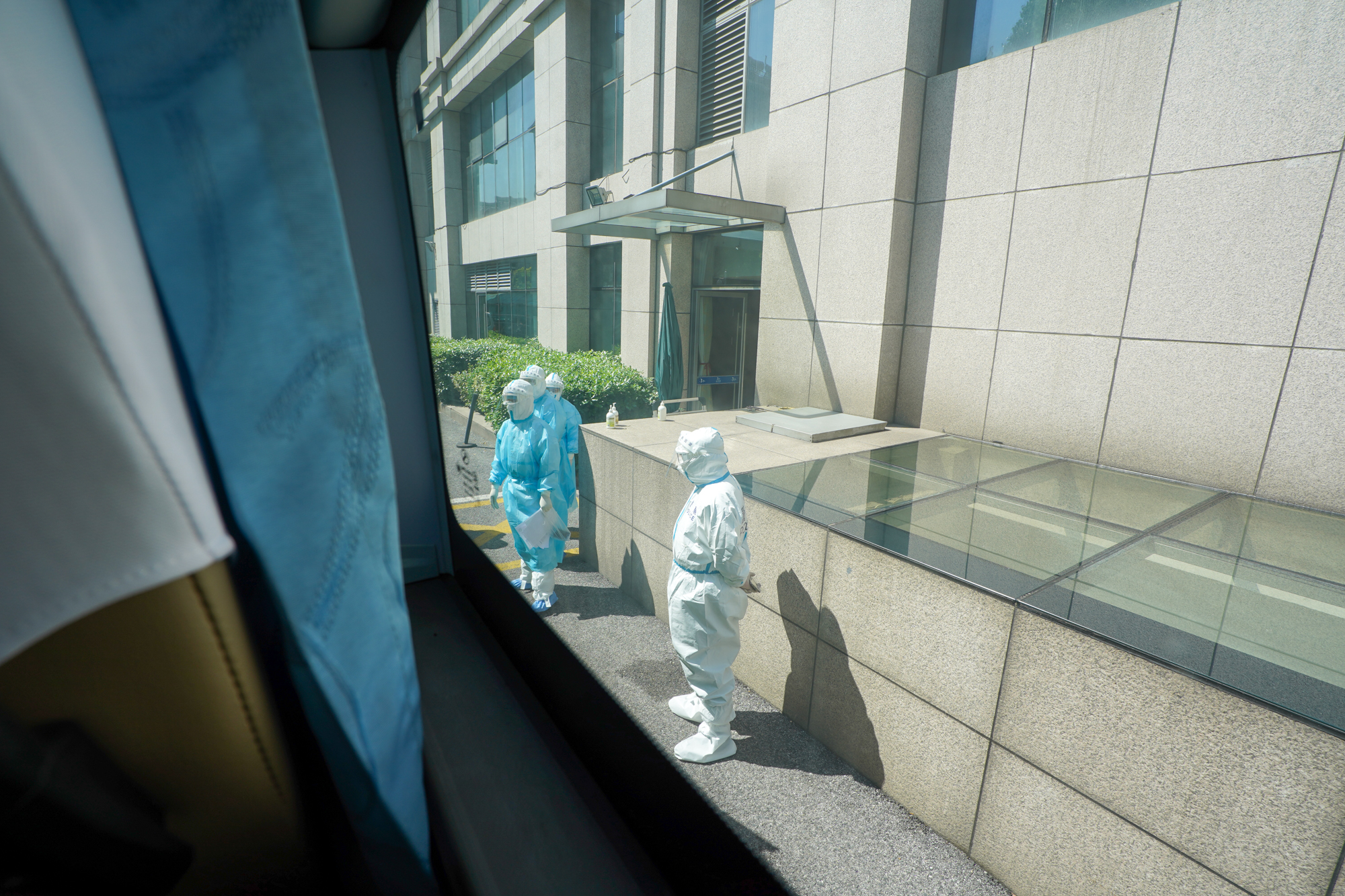
Cost of the Hotel Quarantine
Kitted-out personnel boarded our bus and informed us that the cost of the hotel quarantine would be 500 RMB ($100) per night, for a total of 7,000 RMB ($1,400) for the 14-night stay.
That’s no small expense, of course, and I believe it could’ve been even more pricey at a different quarantine hotel, too. There was no backing out of things now, so I went ahead, signed the document committing to staying in my room and following the quarantine rules for the next 14 days, and paid for the stay.
(It’s too bad I didn’t get a Novotel, Holiday Inn, or Wyndham hotel, which are apparently all possible quarantine locations here in Shanghai. It would’ve been nice to at least earn some hotel points for the $1,400 I spent!)
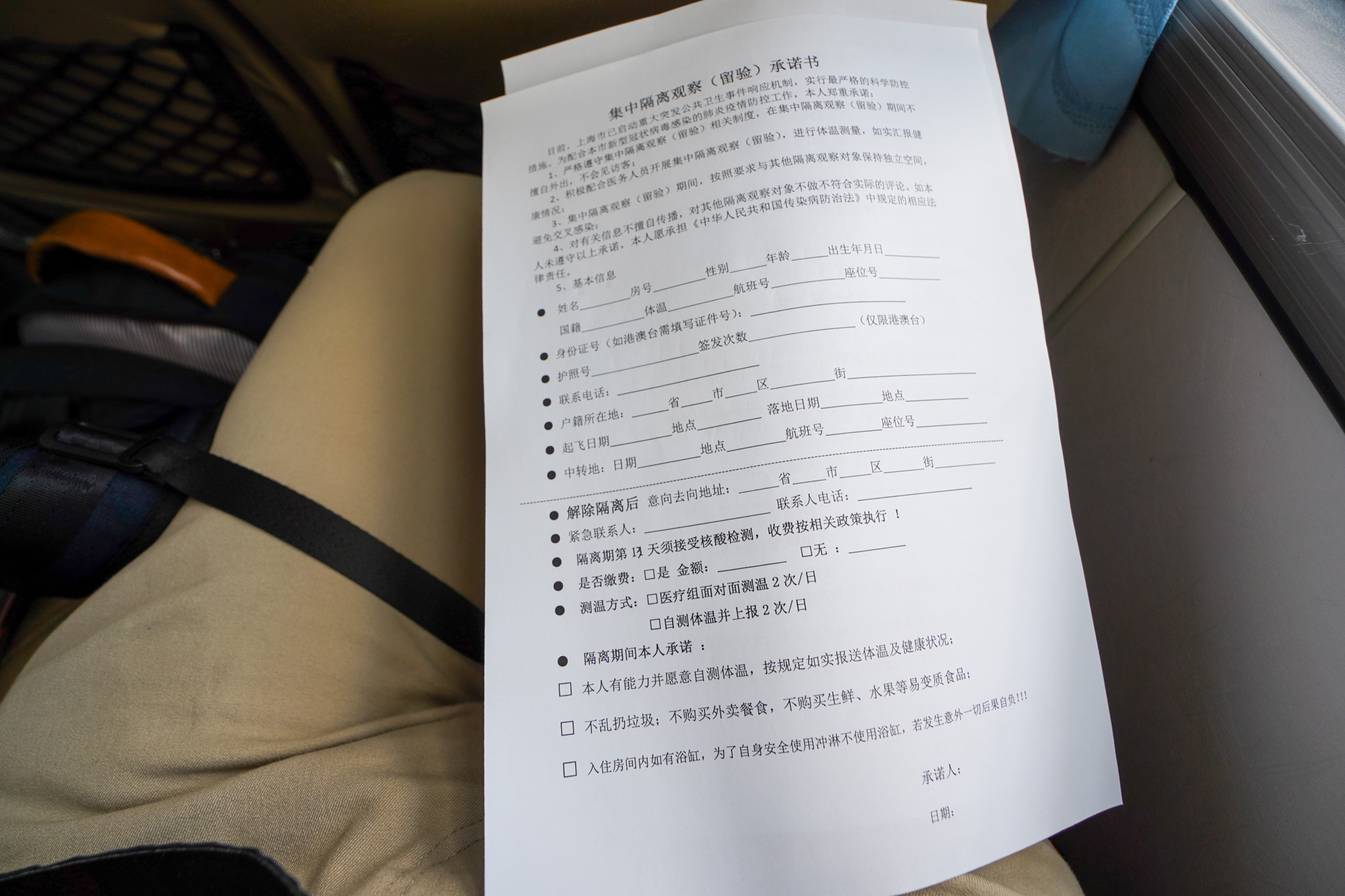
Check-in
We were ushered into the hotel via a side entrance, far away from the regular hotel guests in the main lobby. After taking payment for the stay, the hotel also took note of any meal preferences or allergies I had, before handing me back my passport and the keys to the room.
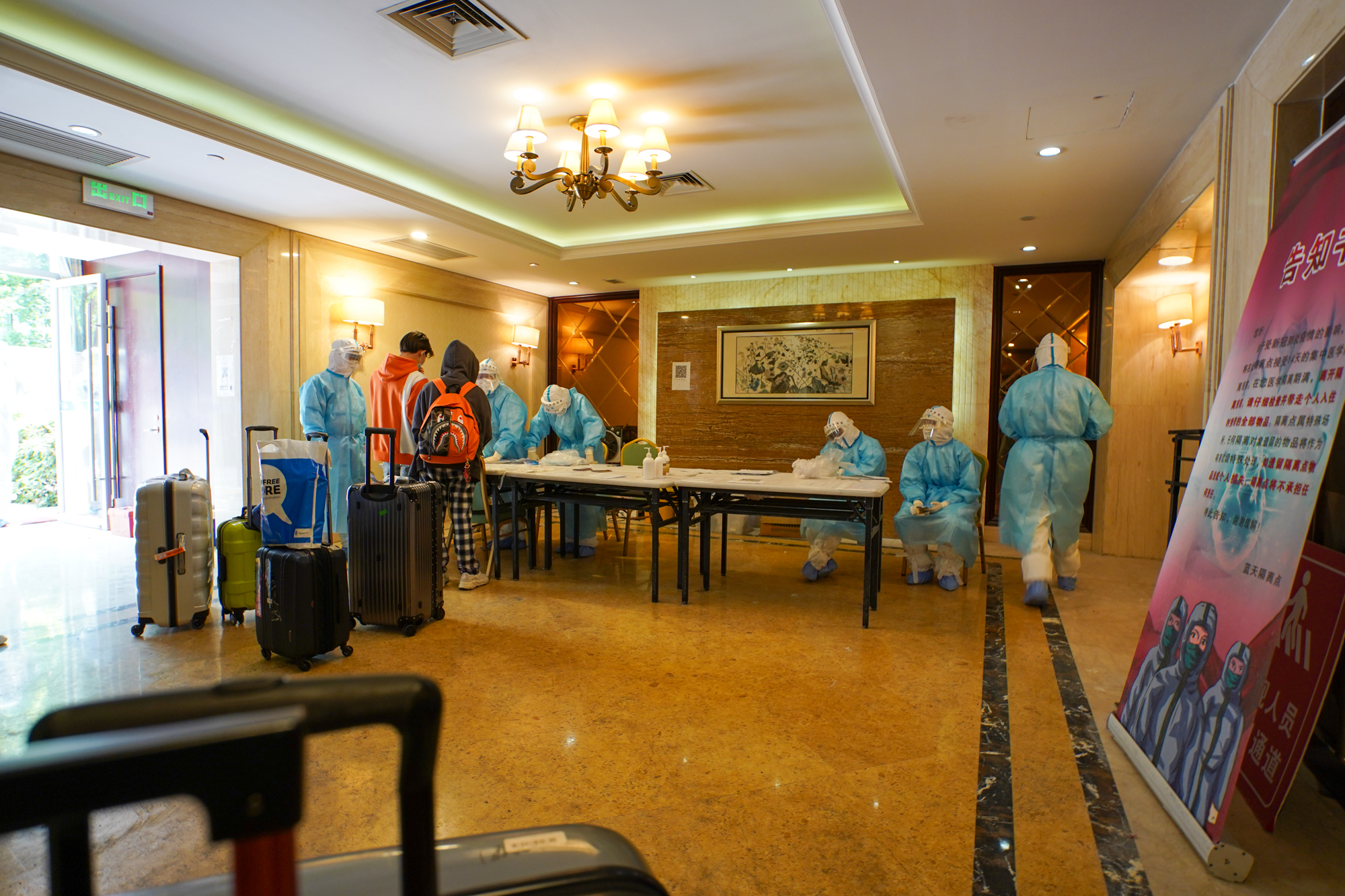
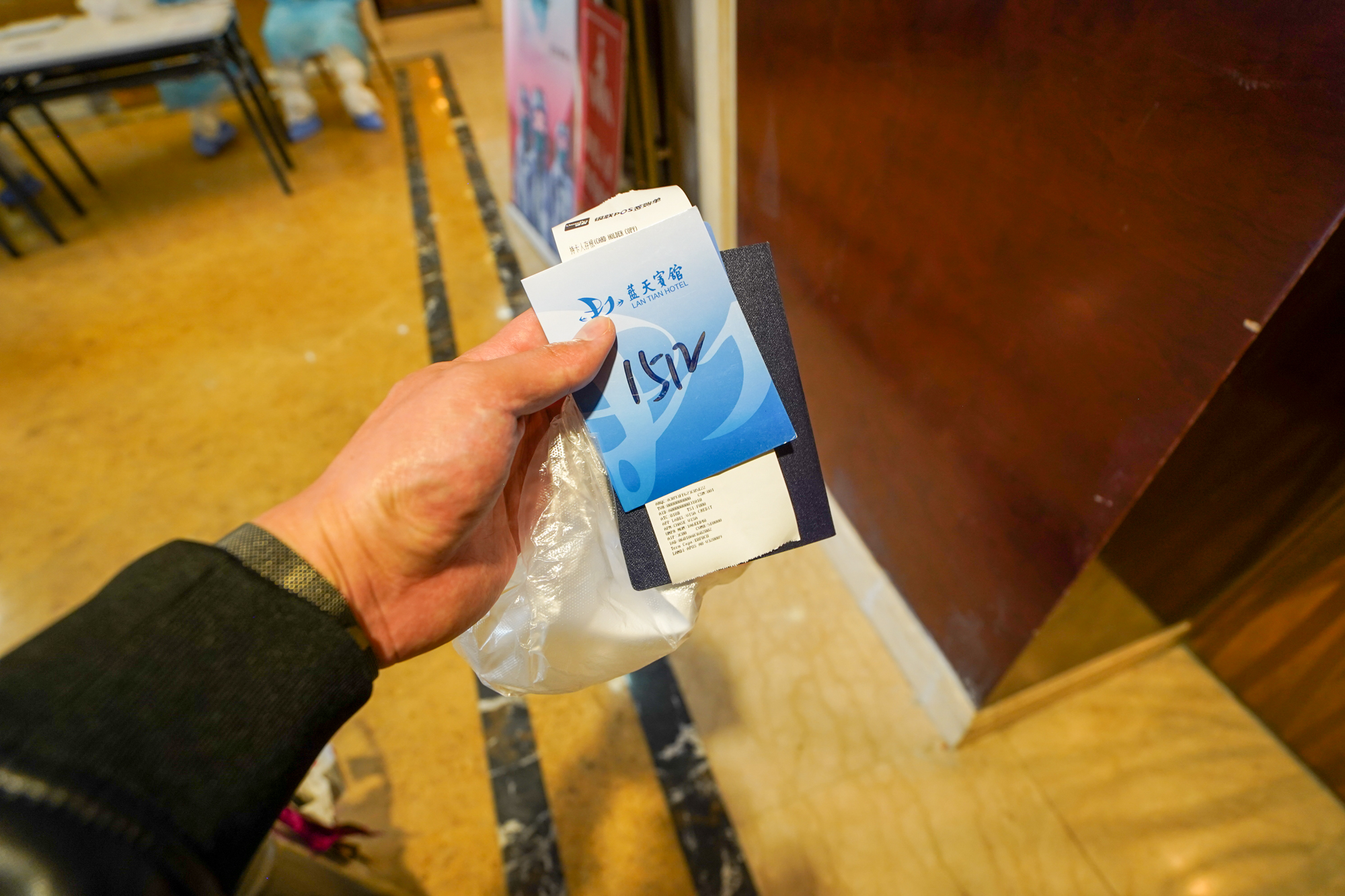
One by one, we boarded a plastic-lined service elevator up to the 15th floor of the hotel, which had been entirely blocked off for centralized quarantine purposes. It was quiet up here, and the hallways were ominously empty besides the lonely table sitting in front of every door.

And with that, I stepped into Room 1514, not to step back out until a fortnight later.
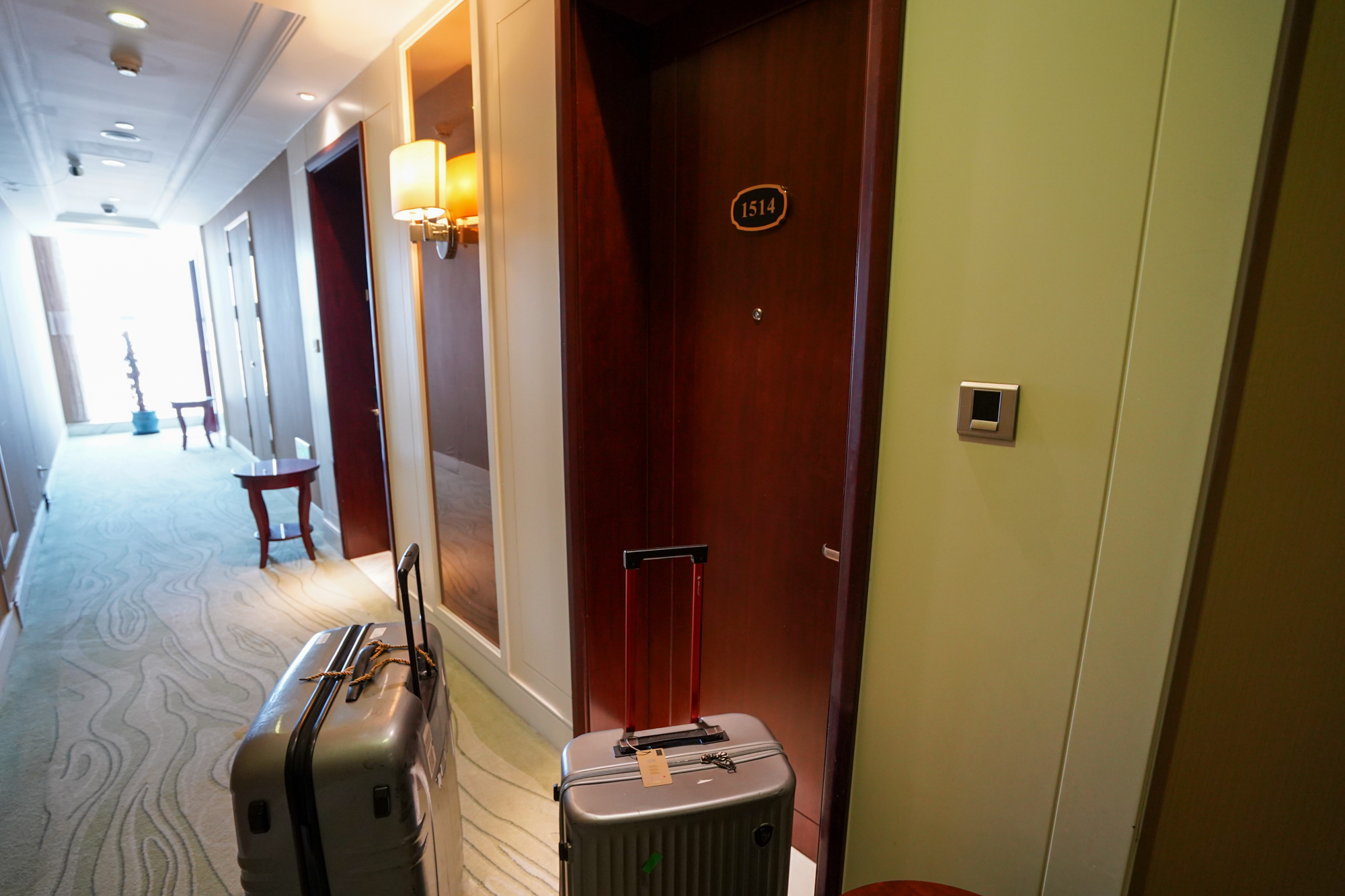
Hotel Room
I thought the room itself was fairly large for a standard non-suite guest room, and I was pretty satisfied with most parts of it.
The centrepiece of the room was the king-sized bed, which provided me with ample rest during the two-week stay – not that there was too much to do besides resting.
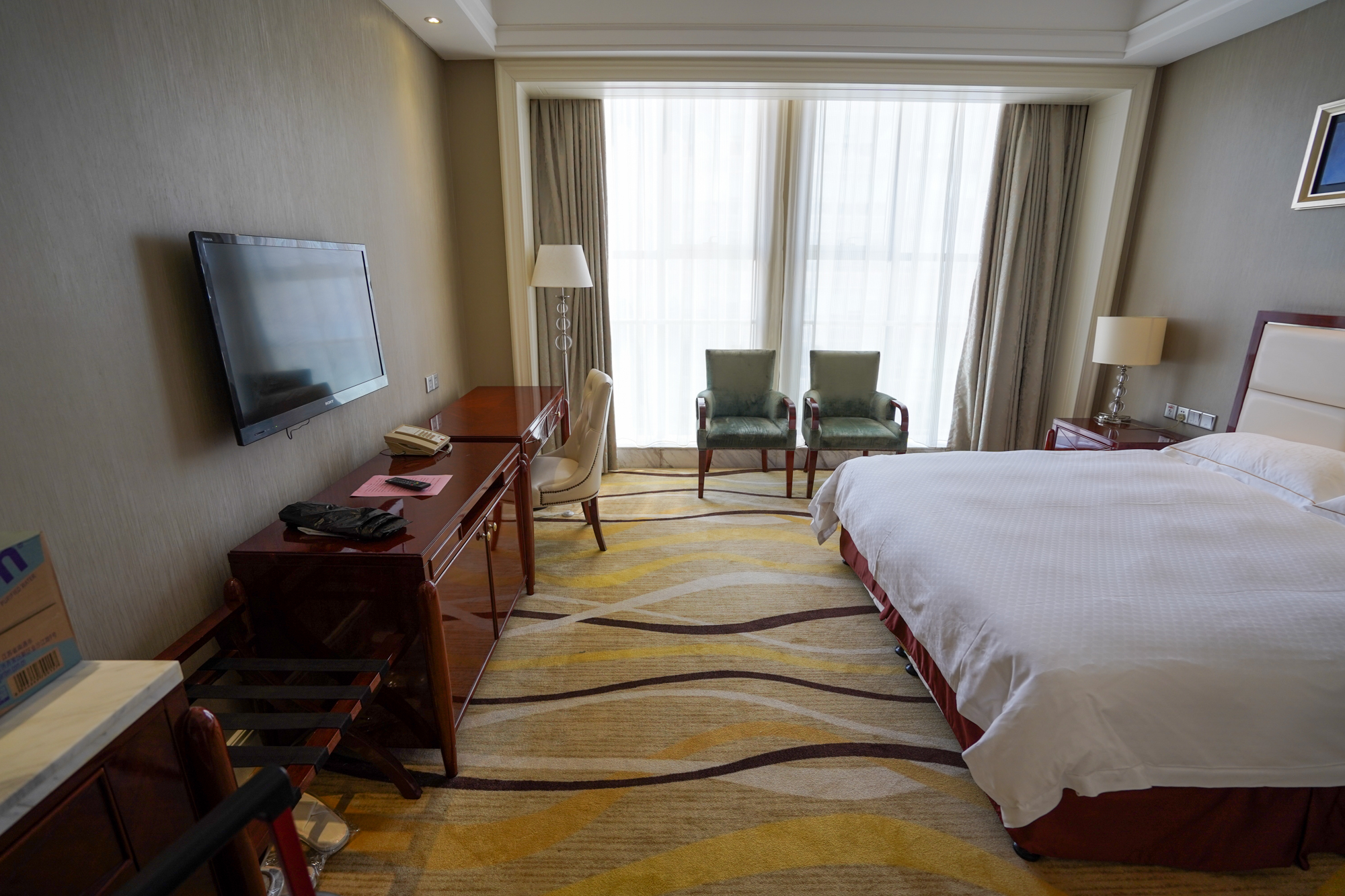
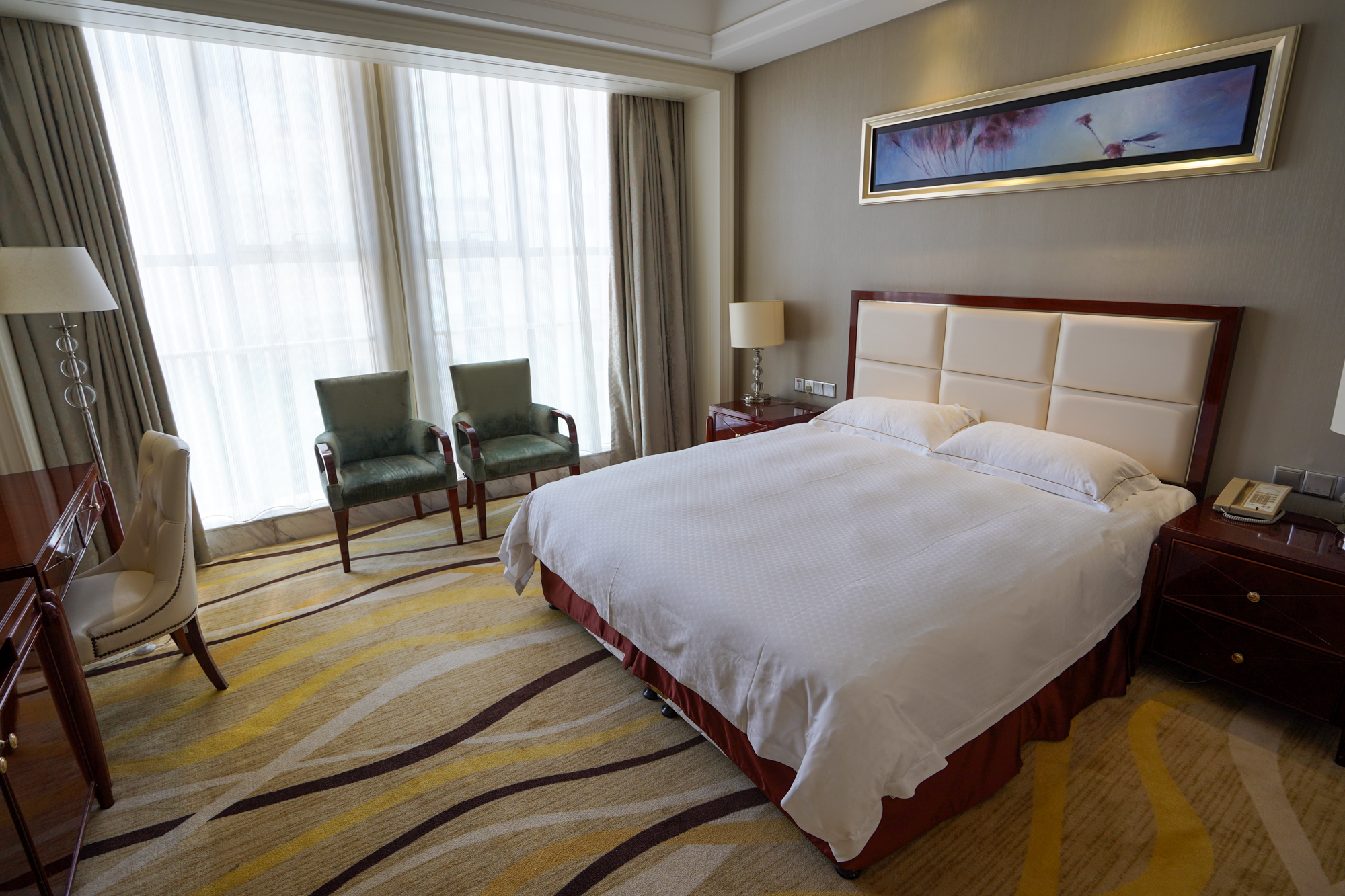
I spent most of my time in quarantine working from the desk in the corner, although the chair was quite uncomfortable to spend long periods sitting in. To break up the work sessions, I made use of the ample carpet space around the bed to do a some floor workouts.
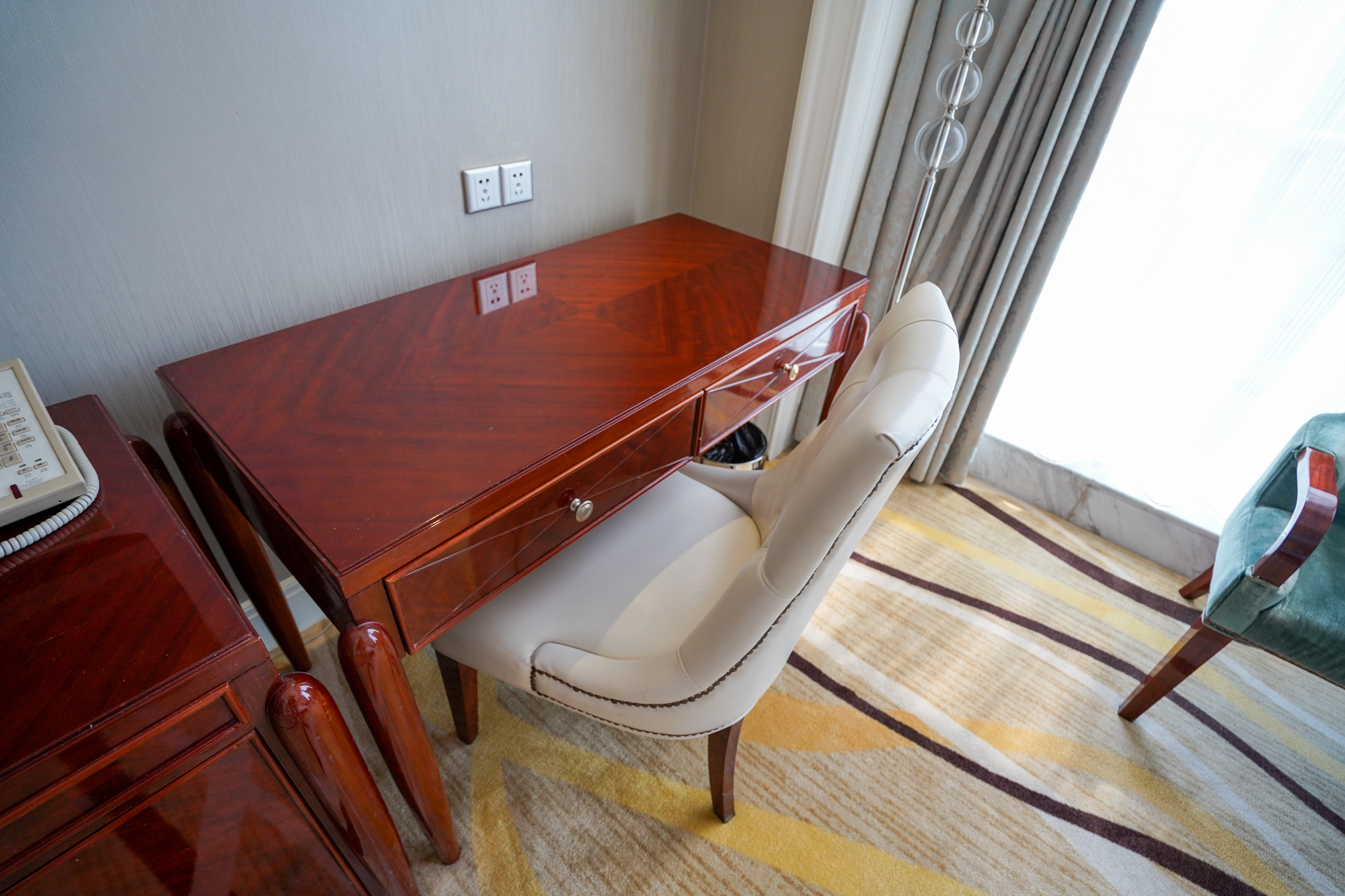
I made great use of the television for watching 3am UEFA Champions League matches – a real blast of nostalgia from my high school days. Meanwhile, the counter space in front of the television would play host to dozens of snacks and drinks that my friends and family would deliver to my door.
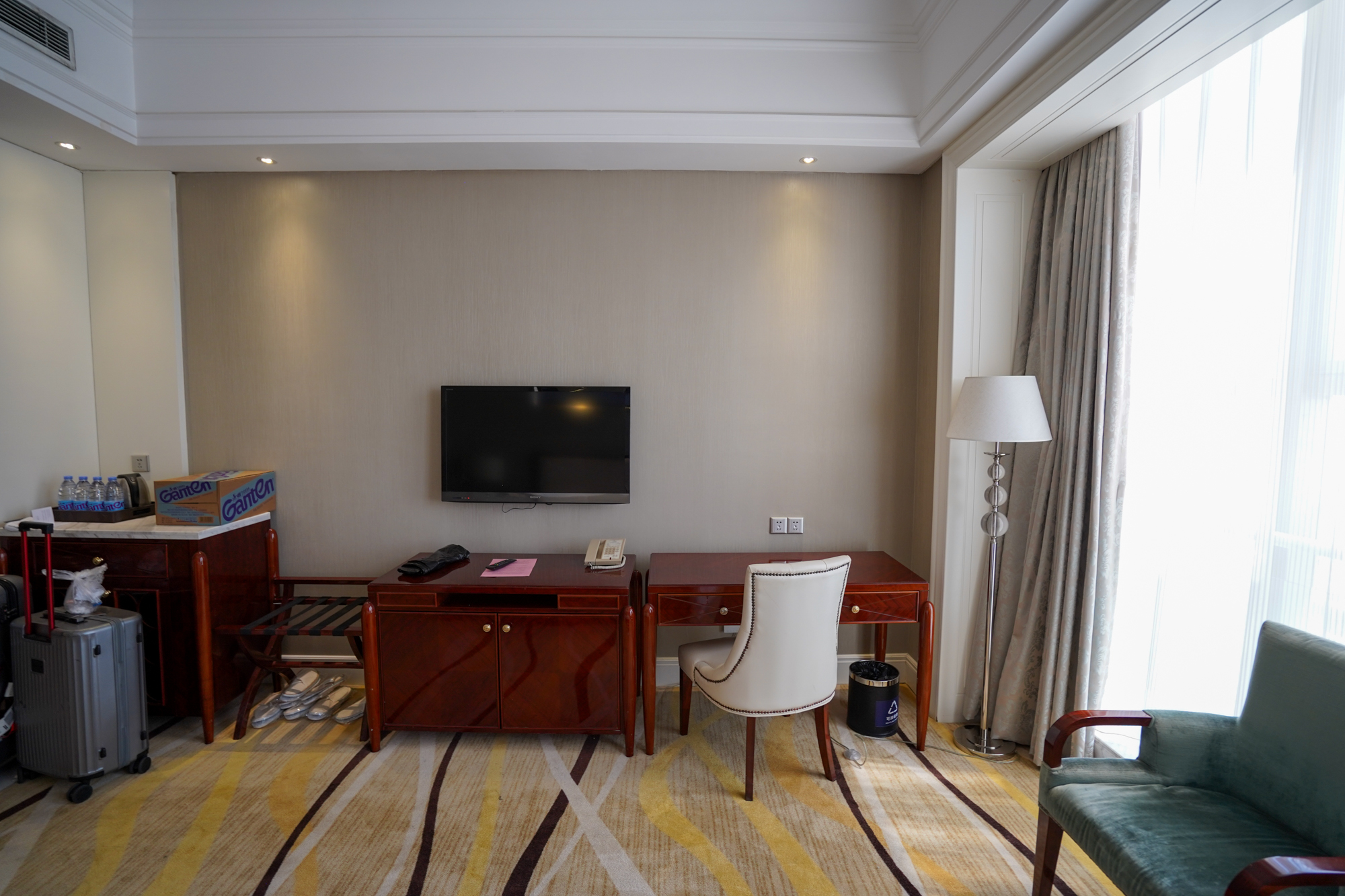
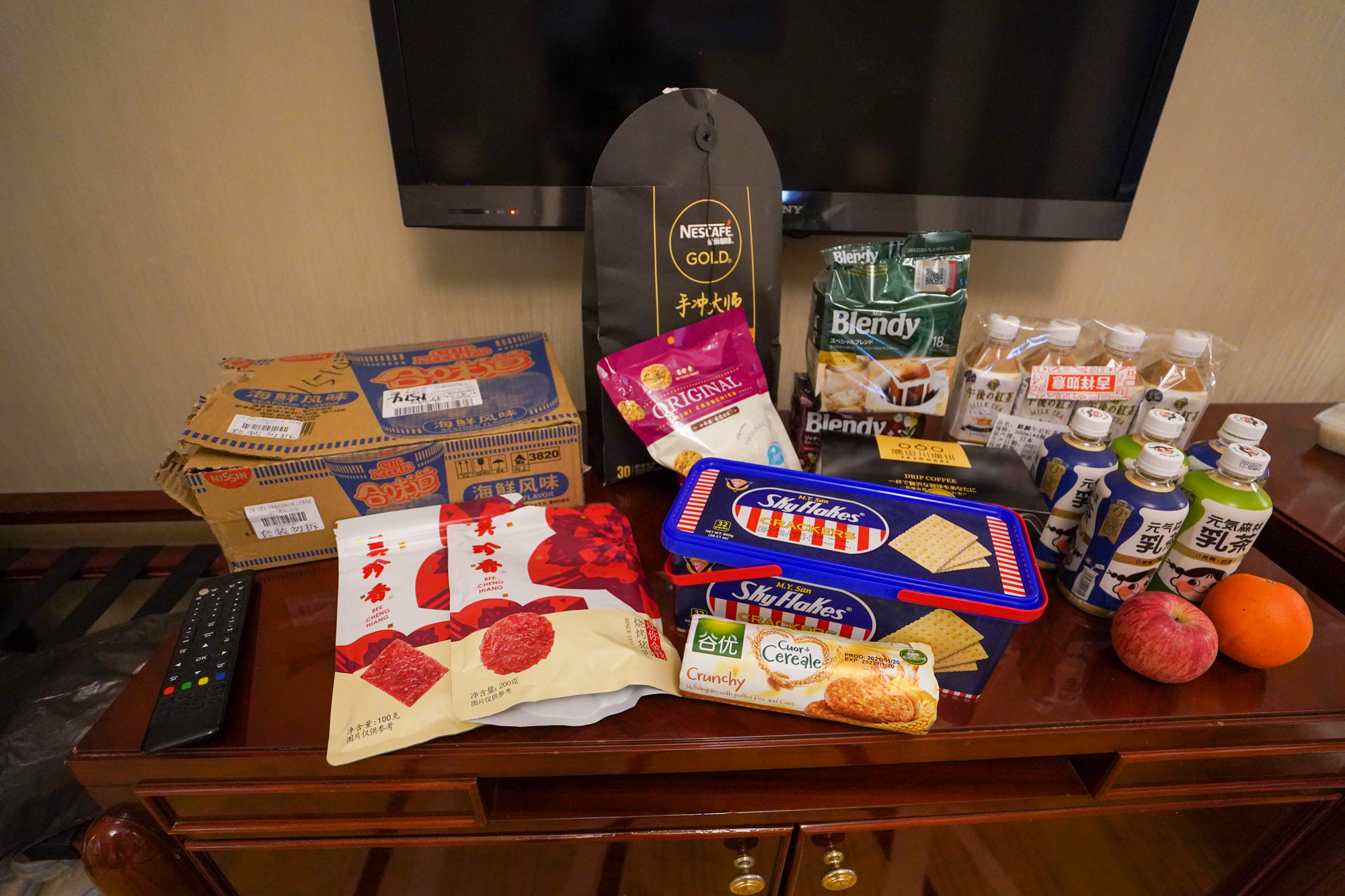
While the bedroom was more than sufficient, the bathroom left a fair bit to be desired.
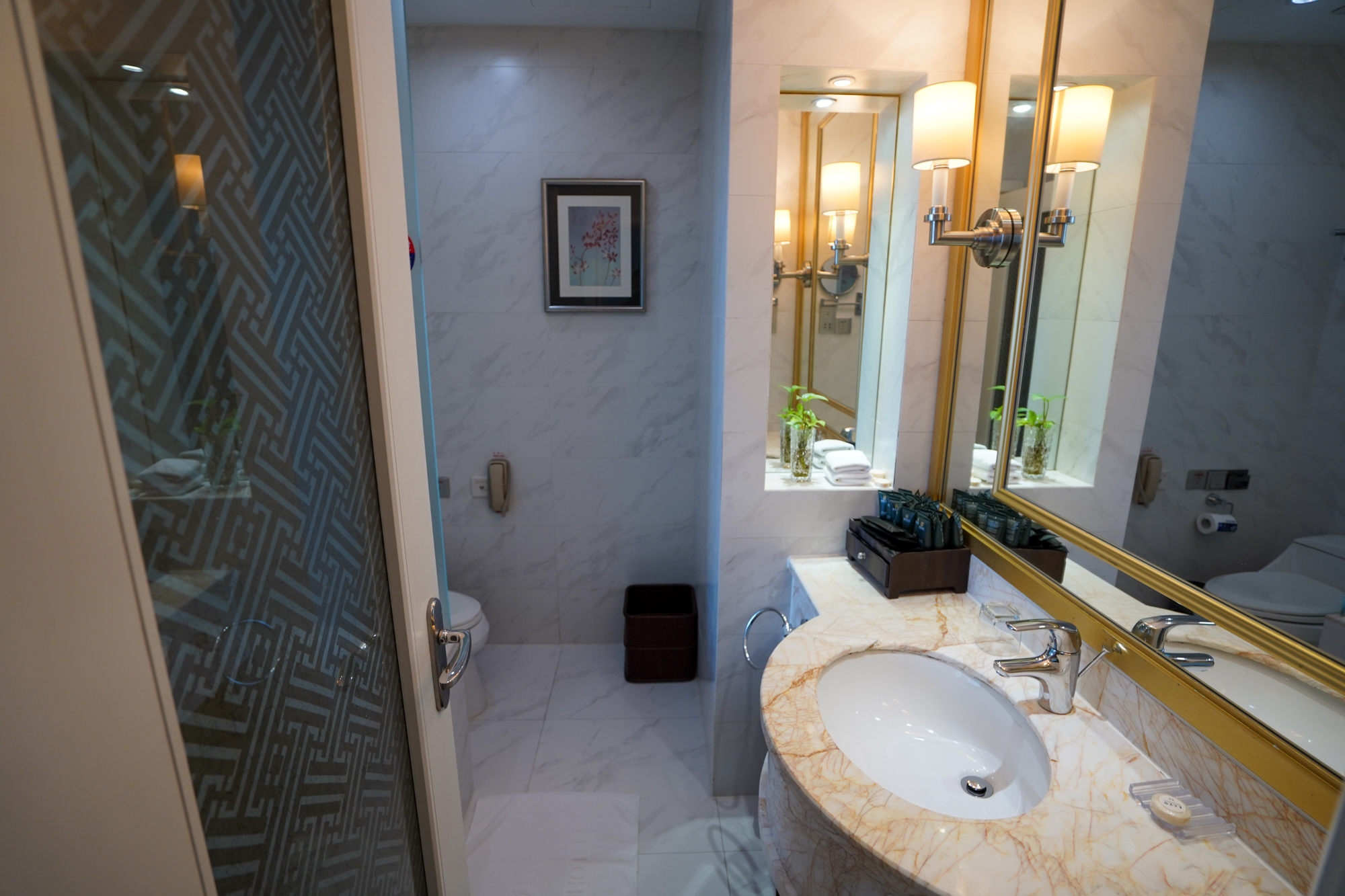
It had all of the essentials: a sink, toilet, and shower/bathtub combo – but the shower would leak water all over the place, and it also became very clogged over the course of two weeks (with no housekeeping service allowed in the room during that time, of course).
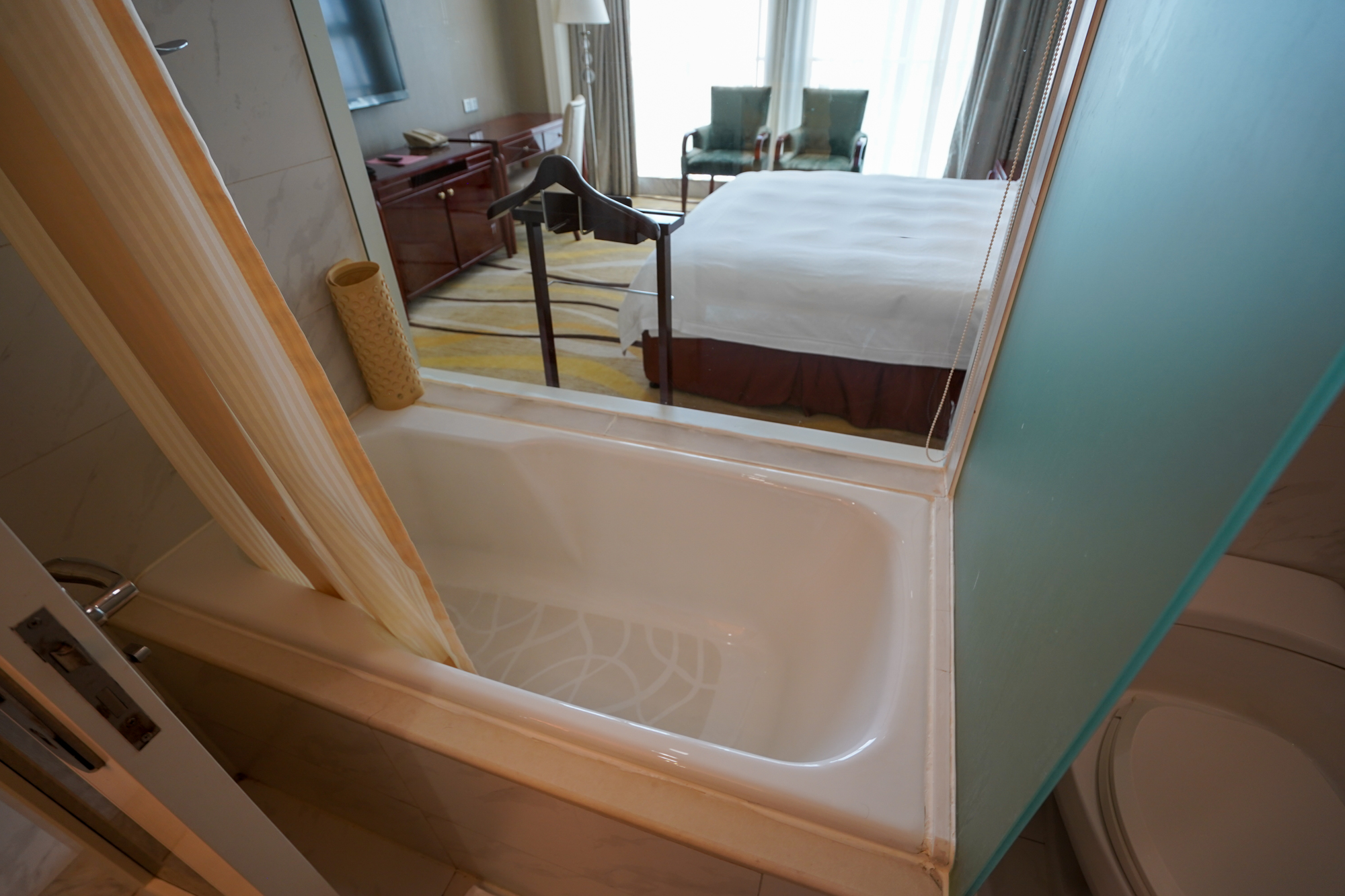

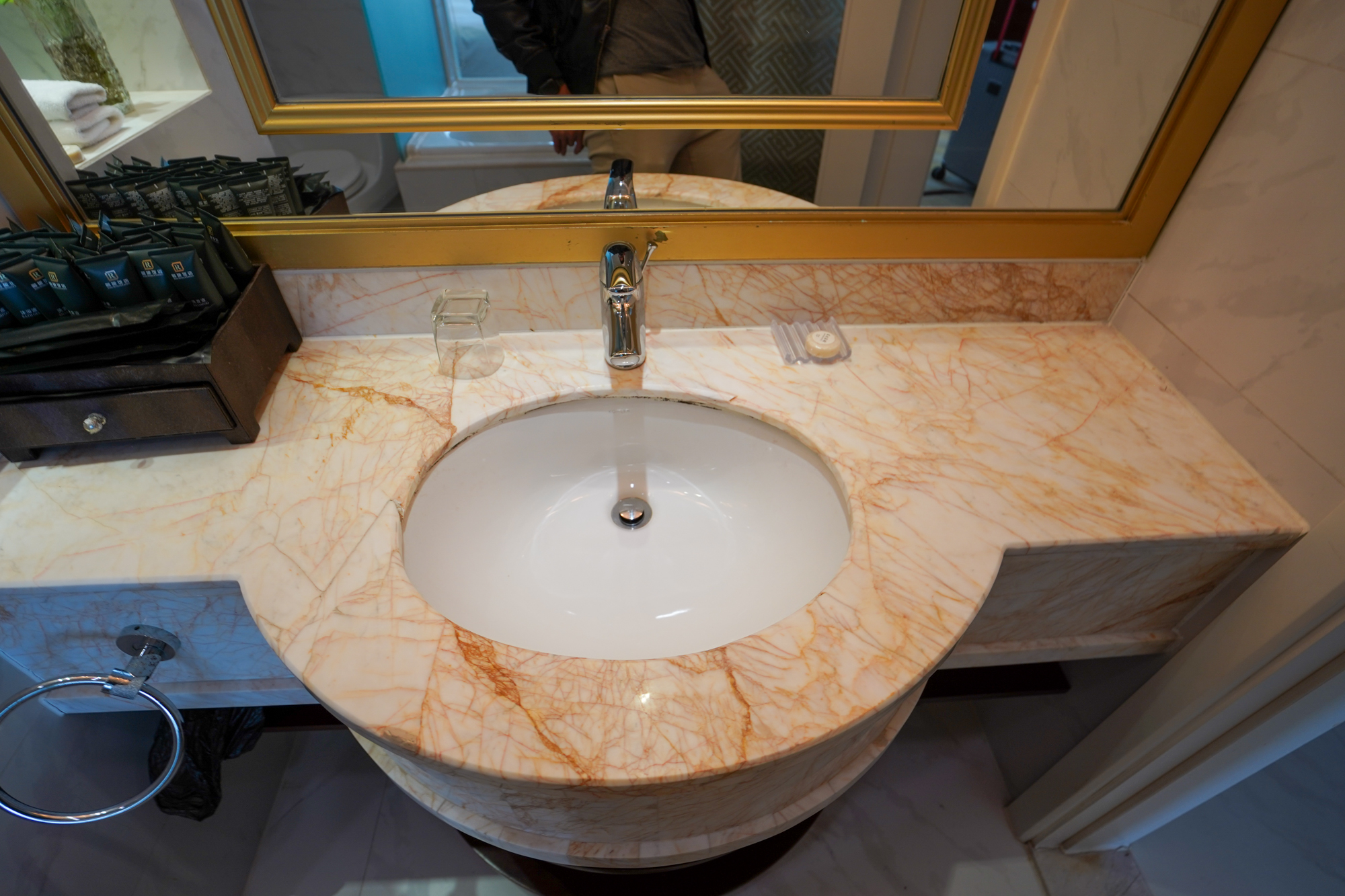
I ended up trying to spend as little time as possible in the bathroom, and needless to say, I was very happy to be out of there by Day 14.
Meals
The Blue Sky Hotel delivered me a total of 42 meals, starting with lunch on Day 0 (the day of my arrival) and ending with breakfast on Day 14. Each meal was left on the table outside my room, and then the front desk would call me to let me know that the meal was ready.
The meals were fairly consistent, but there was always a little bit of variety to keep things interesting from day to day.
Breakfast was served at 7:30am every day, housed in an aluminum wrapper in case I didn’t wake up until later (even though I was always up by early morning anyway). The breakfast box would uniformly consist of a piece of corn and a hard-boiled egg, accompanied by various other breakfast items.

Some days there’d be a sweet bun, other days a savoury bun, and yet other days a sausage, yam, or even a zongzi (sticky rice dumpling wrapped in bamboo leaves).
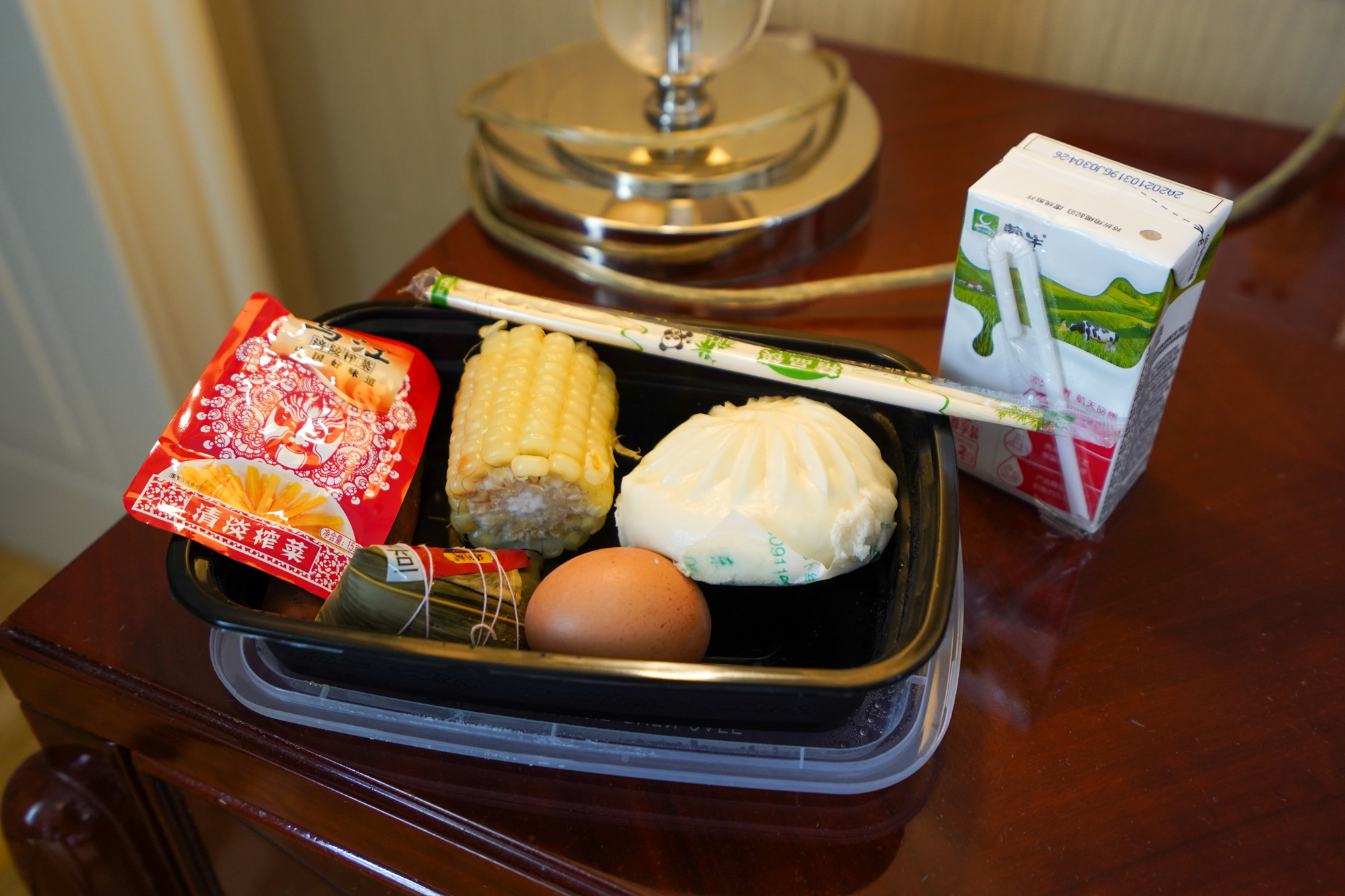
There would always be a packet of Chinese pickled vegetables to accompany the plain stuff, as well as a carton of milk – although Day 7 saw the regular milk seemingly arbitrarily replaced by soy milk.
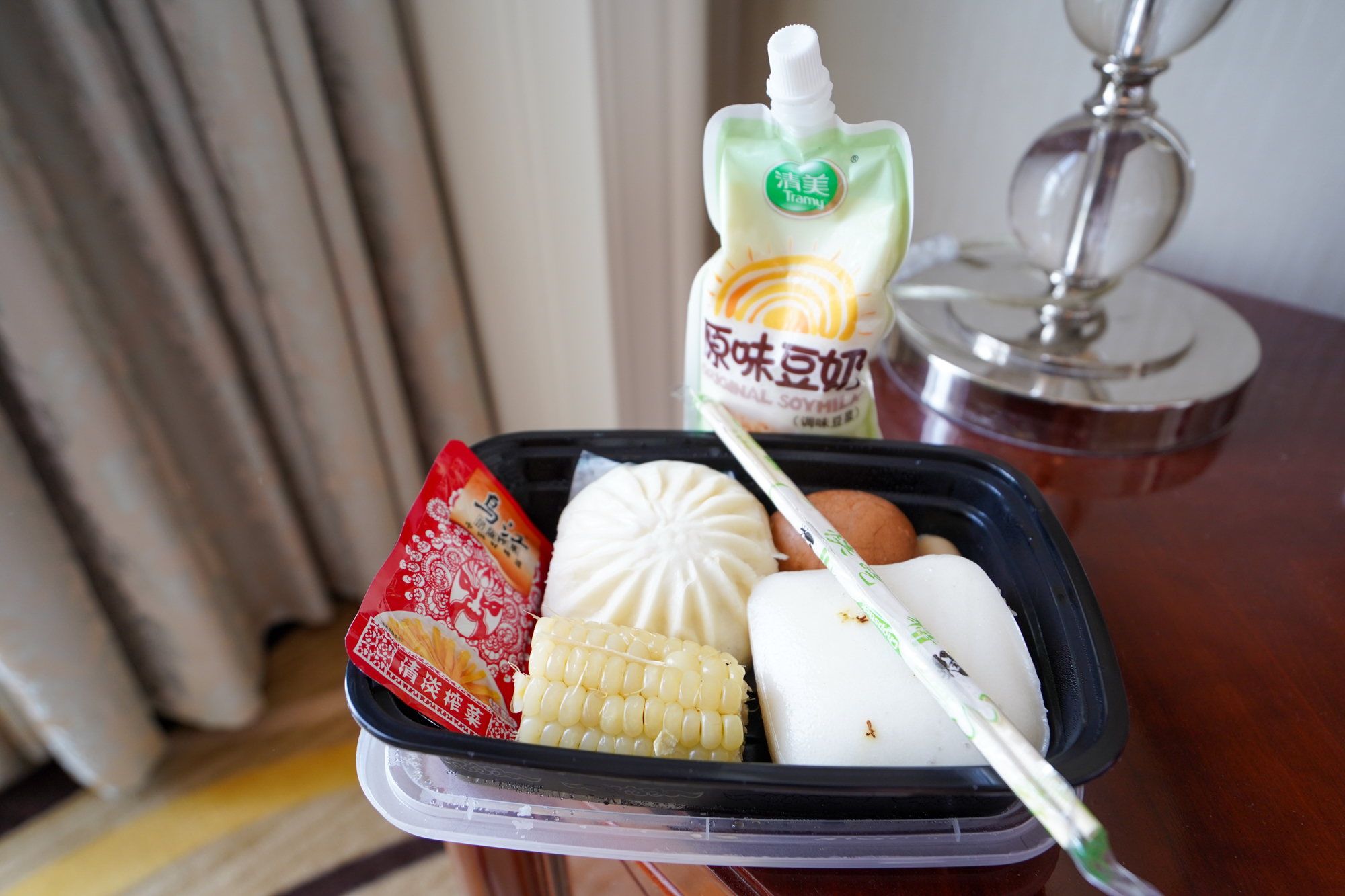
Lunch was delivered at 12pm every day. There’d always be a big box of rice, along with a four-part lunch box that contained various protein and vegetable dishes. Chicken, beef, fish, duck, shrimp, tofu – I had it all over the 14 days.
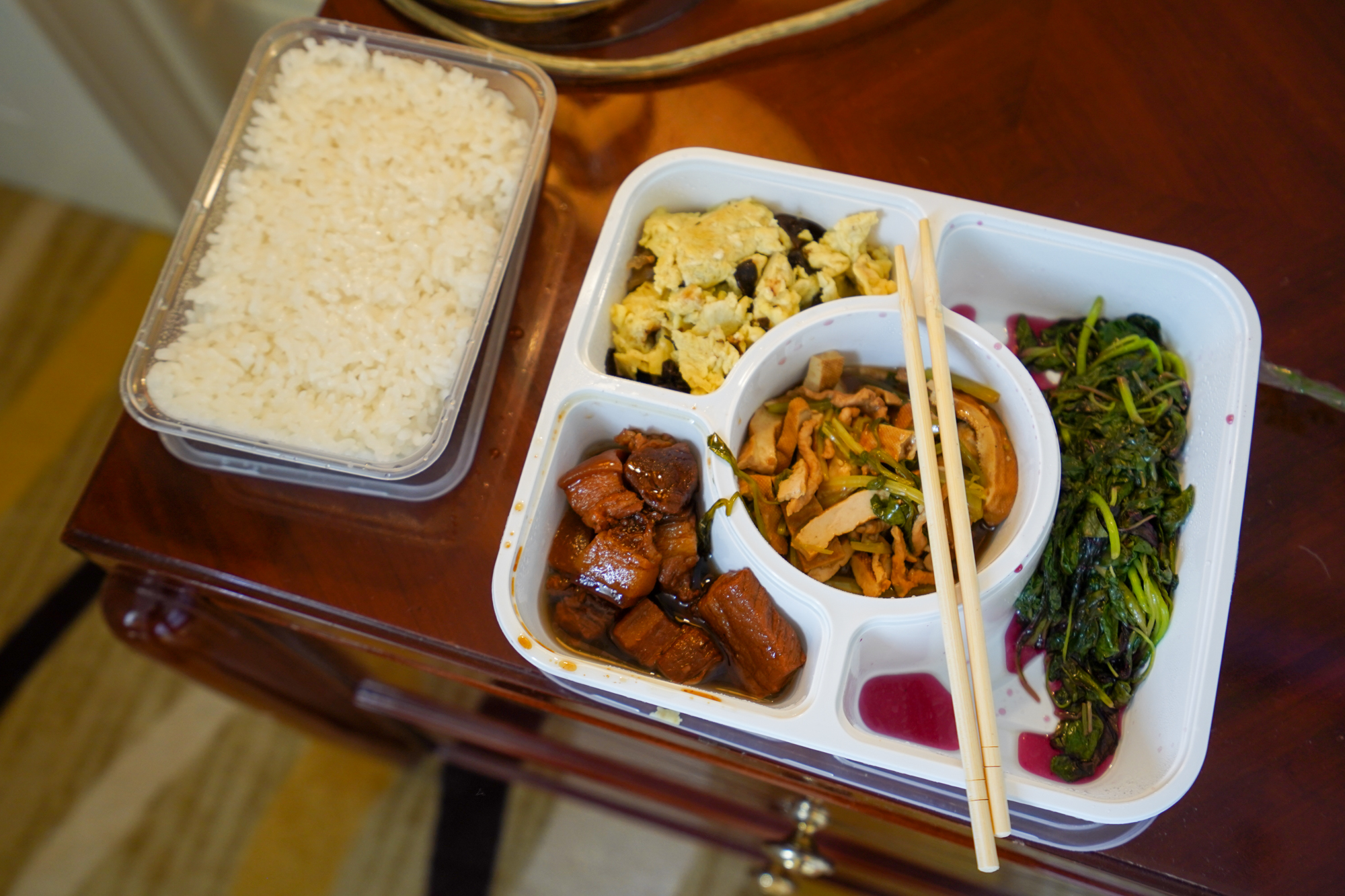
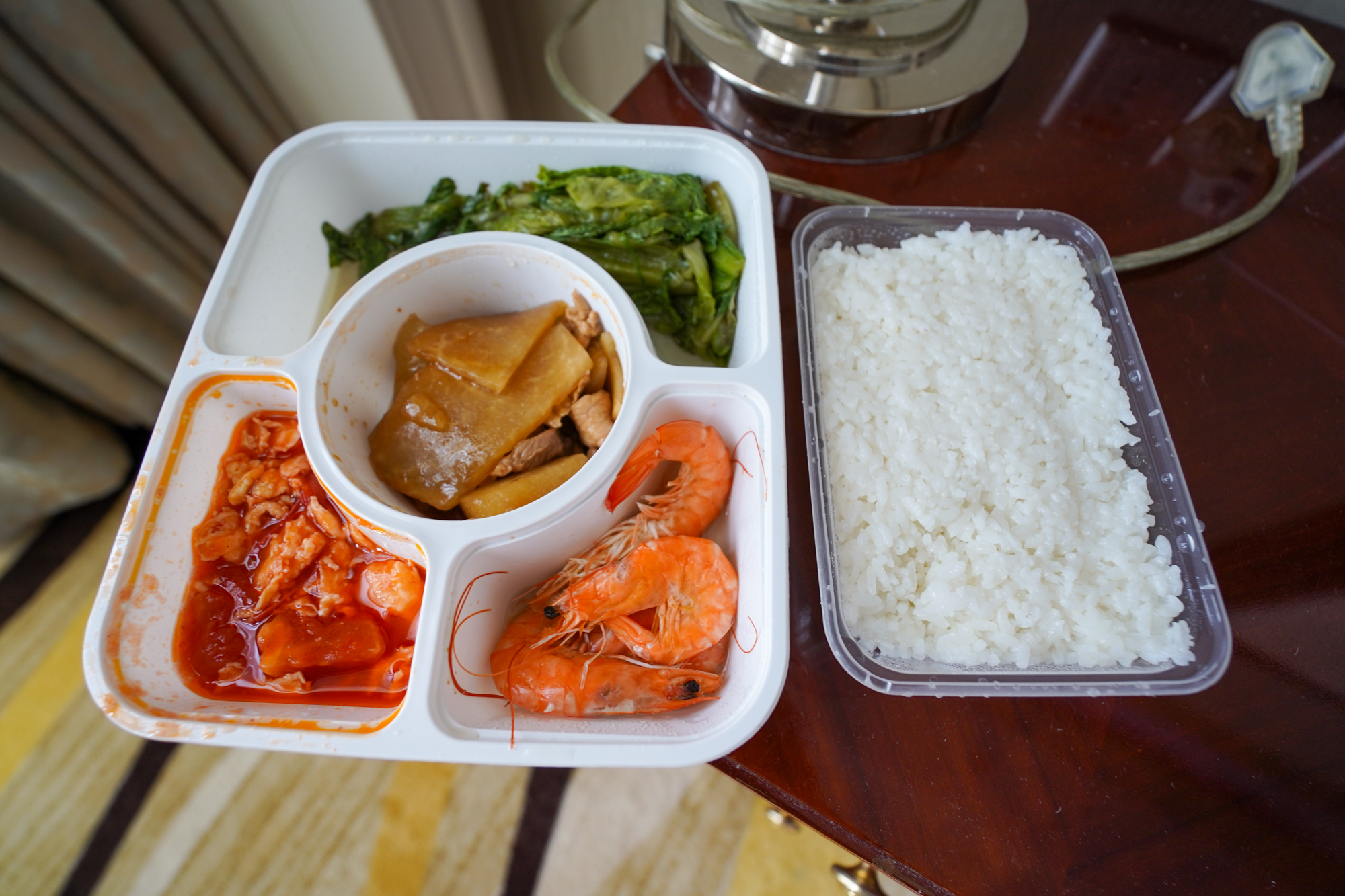
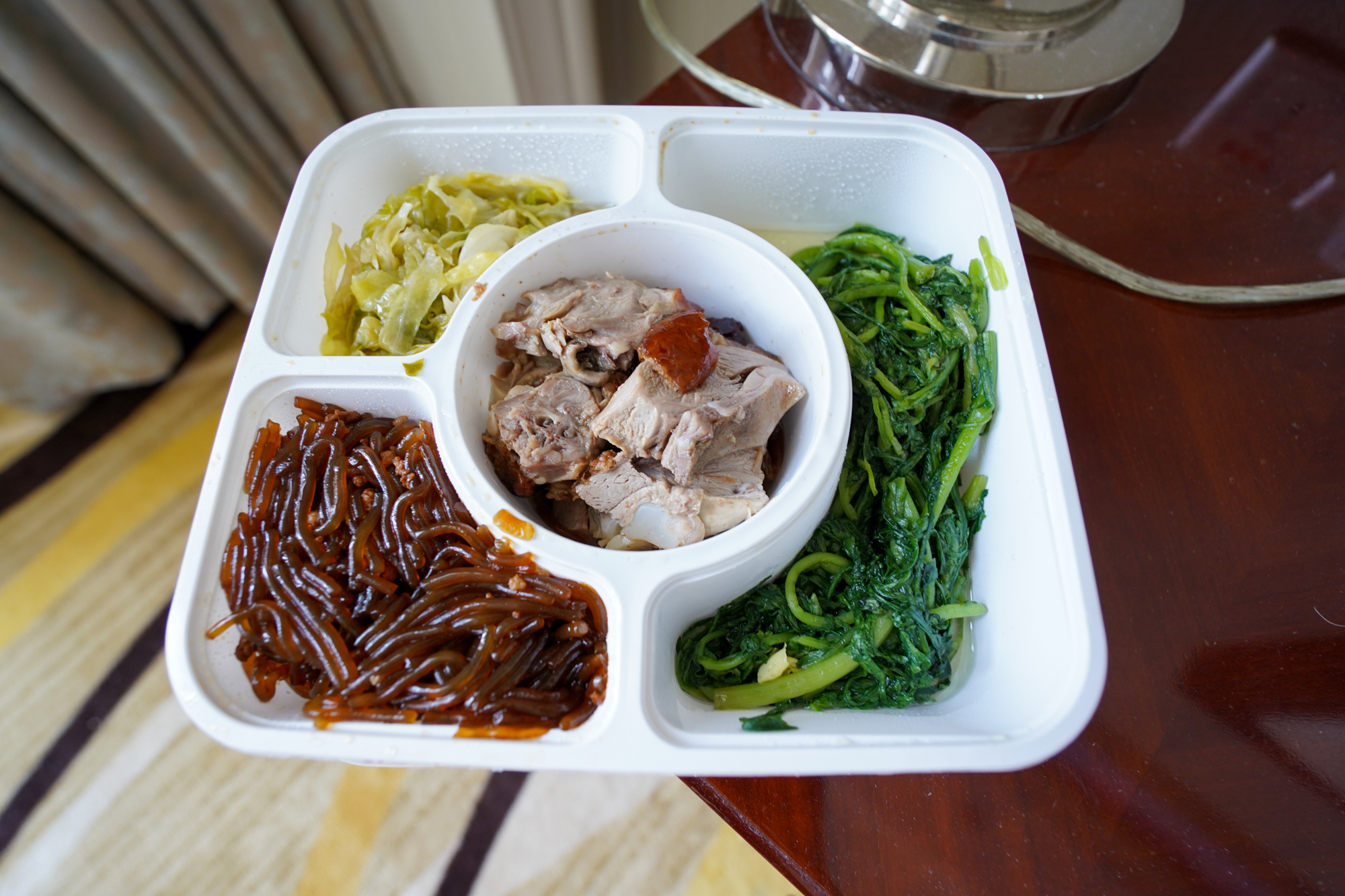
(I guess the Day 7 was the day of culinary surprises, because it was the only day that I received a bowl of seaweed soup with my lunch.)
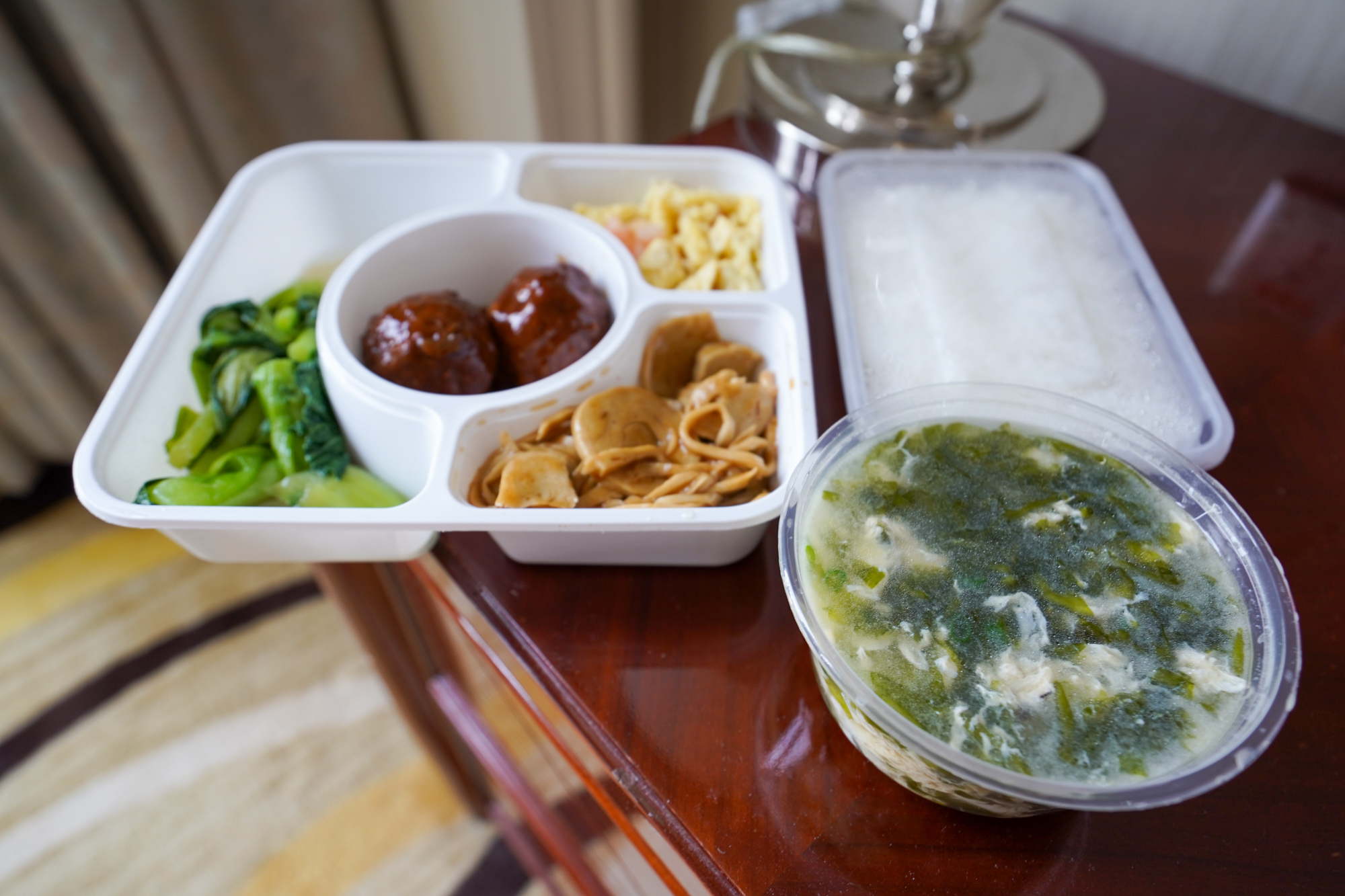
Finally, dinner would arrive at 6pm every day, again featuring a box of rice and a lunch box with rotating contents, as well as an orange on the side. I noticed that the items appeared to rotate on a roughly weekly basis, as I started getting the same stuff for lunch and dinner on Day 8 as I had received on the first day.

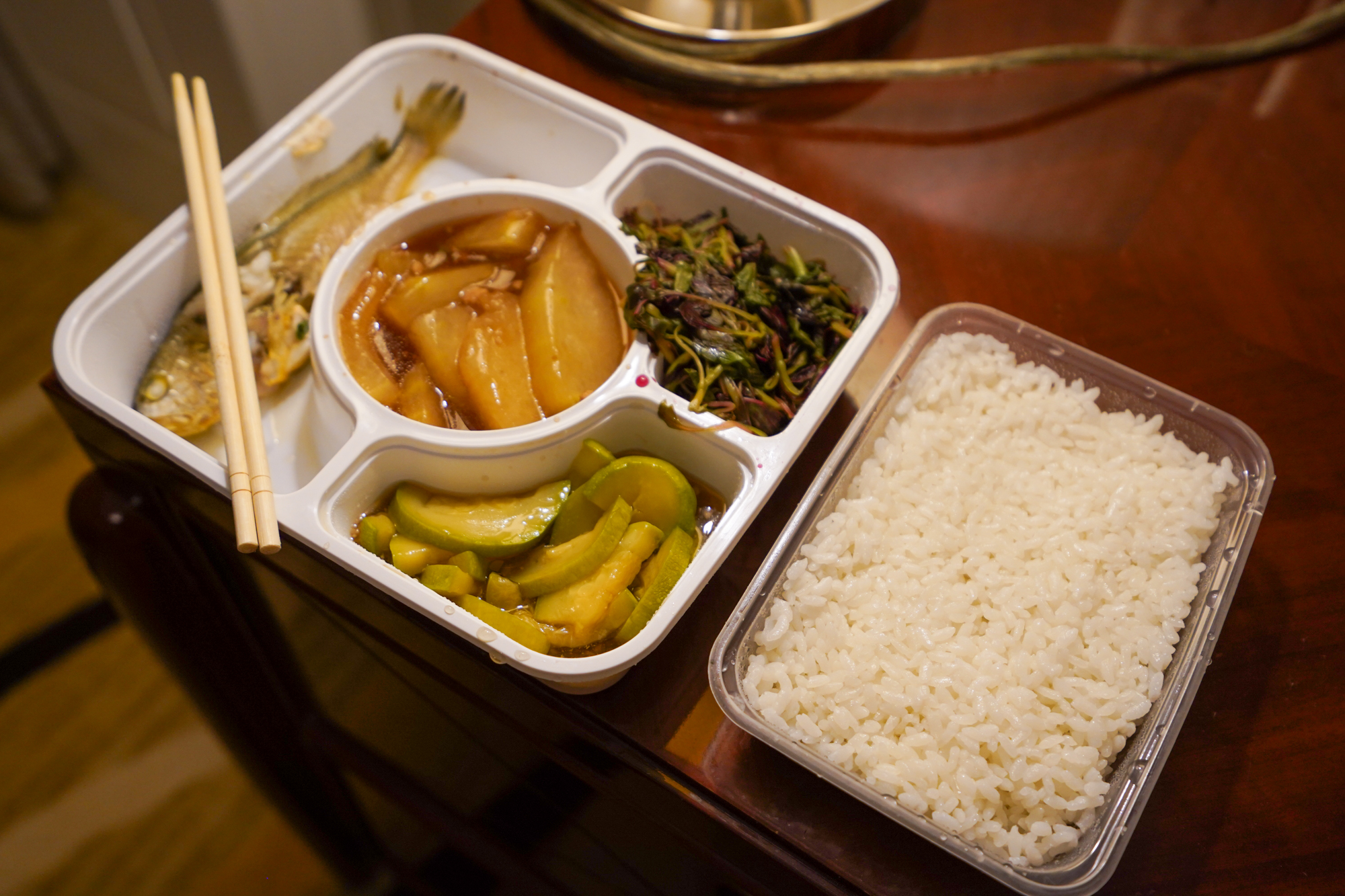
Overall, the meal contents were healthy, and I thought the portion sizes were decent. On some occasions, I woke up from a jet lag-induced sleep with a grumbling stomach, but that’s where my mum’s shipment of cup noodles did the trick for a few hours before breakfast would arrive.
The Blue Sky Hotel did not allow me to order food delivery from outside restaurants, although this varies from hotel to hotel – if you’re travelling to China and get assigned a different quarantine hotel, you might be allowed to order in.
However, the hotel was happy to accept parcel deliveries to my door, resulting in my mountain of snacks on the TV counter.
14 Days of Quarantine
I think I handled the 14-day quarantine ordeal pretty well, all things considered. I had started to get a little bit “stir crazy” by Day 6 or 7, but consciously focusing on work and building a routine into my day allowed me to get through the entire 14 days pretty painlessly.
It certainly helped that breakfast, lunch, and dinner were delivered like clockwork at set hours throughout the day. In-between meals, I’d set aside some time for my floor workouts every other day (there wasn’t really anything I could use as weights in the room, so a series of every-minute-on-the-minute exercises had to suffice), give Jessy a call back at home, or otherwise work on Prince of Travel.
The days certainly seemed to blend into each other over the two weeks, and I often had to stop and remind myself which day I was on as I watched sunrise after sunrise, sunset after sunset in the Wujiaochang intersection outside.
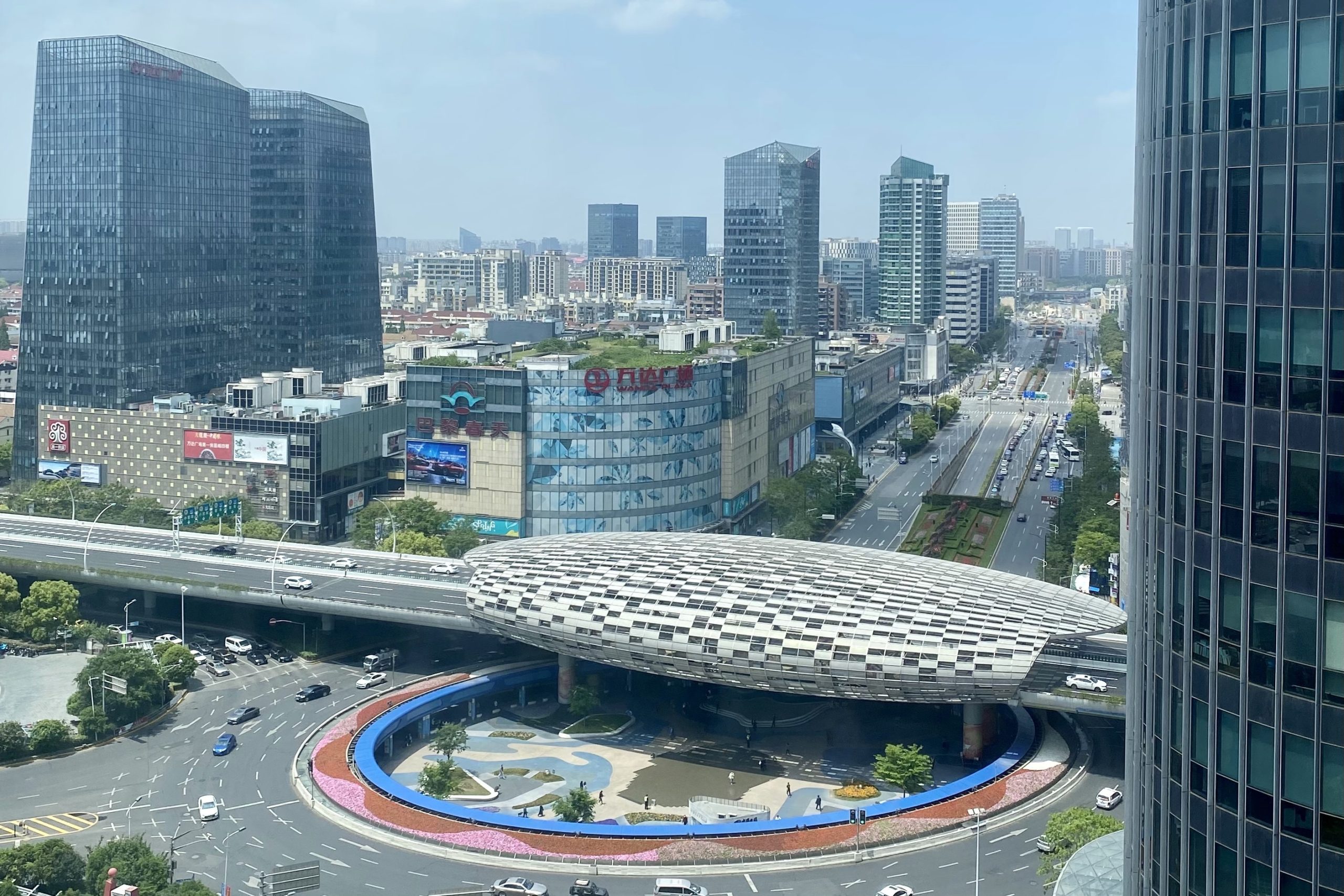
The jet lag made things even more challenging in that regard. Since I couldn’t leave my room, I had no option but to succumb to the jet lag every time.
I recall it was around Day 4 that I had slept from 4pm to 12am, and then from 8am to 12pm, and then from 5pm all the way to 11pm – missing out on dinner entirely!
It would eventually take me almost the full 14 days to properly adjust to the local time zone, such was the sheer attraction of the king bed and its fluffy blankets whenever the jet lag kicked in.
Temperature Checks and COVID-19 Test
Every day at 9am and 2pm, a kitted-out staff member would ring my doorbell to conduct a brief temperature check. My readings came in between 36˚C and 36.5˚C every time, so there was nothing to worry about.
In addition to the COVID-19 PCR tests I had done upon arriving in Shanghai, I then had to conduct another test on the morning of Day 13, the results of which would allow me to exit my quarantine on the final day. We each pulled up a chair to the door and had our noses swabbed (again, extra deep).
(I had been under the impression that I’d have to do even more tests throughout this process, so at least I was happy it was only one additional test after the one upon landing.)
A few hours later, I received the fateful phone call letting me know that my test results came back negative, and I’d be able to leave the hotel the next day!
At 7am the following morning, I packed up all my belongings, guzzled down the last of my snacks and drinks, and – with my sanity still intact, as far as I could tell – made my way downstairs for checkout.
Conclusion
Arriving into China during the pandemic era certainly made for a very challenging journey, from the visa application back in January, to the pre-travel COVID tests, to the 17-hour flight with a stop in Seoul, all the way to a full 14 days of isolation in a hotel room all on my own.
Now that I’ve come through it all, I’m really happy that everything went as smoothly as it possibly could, and I’ll be looking to make the most of my time here over the next month or so to make all the efforts worthwhile.
In a few years’ time, I might look back on this trip as a somewhat unique experience to have gone through, but I must say that it isn’t a process I’d be eager to undergo again.
It’s certainly been a tough year for many people around the world who have been separated from family or who have faced arduous processes to reunite, and I can only hope that things get better for us as soon as possible in the coming weeks and months.


















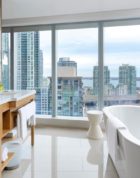

Thank you, Ricky! Great info. for my upcoming trip to Shanghai!
Glad it was helpful!
Hello Ricky, great information for traveller who want to travel to China. I am born and rise from Beijing and would like to visit my family when the restriction ease off. Just curious if I book an Aeroplan reward ticket from YYZ-PEK on later days (for example: December), and the plane will not take off due to the COVID restriction, am I able to book the same route later with the points I pay now like you did with the old program. Thanks
Not that I am planning this trip, but my question is whether it would it be possible for a non-Chinese speaking person be able to manage this trip.
Thanks! Great information for us as we are planning a similar itinerary to Beijing on a family visa. We are holding off presently in the hope that restrictions will be eased and direct flights resumed. We are also unclear about medical insurance validity. I assume regular travel medical insurance provided by a credit card is invalidated if you travel during a pandemic and specialized COVID specific insurance needs to be sought out. Do you have any advice regarding obtaining medical travel insurance during this period of time?
It would be possible but a fair bit trickier. You’d need all of your usual wits about you when it comes to travelling in any place where you don’t speak the language. And if at any point you really aren’t able to understand what’s going on, there’s usually an English-speaking staff member somewhere that they can track down. Having a friend you can contact on WeChat who can help you out will also be very useful.
Thanks so much for writing this, Ricky! My mom is planning to go back to China to visit my grandparents who are in the hospital as well, so I forwarded this to her and she found it very helpful in helping her prepare and understand what to expect. I hope your grandfather is doing better and that you get to see him soon in Beijing.
My pleasure Chris, and thanks for the good wishes.